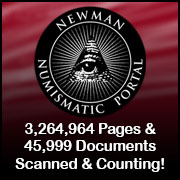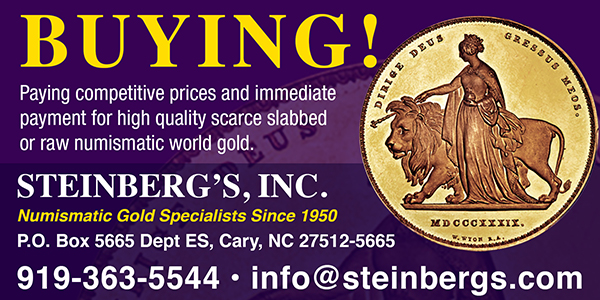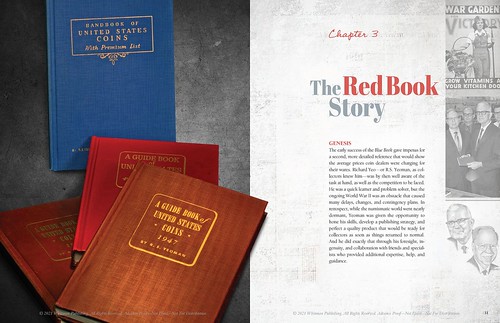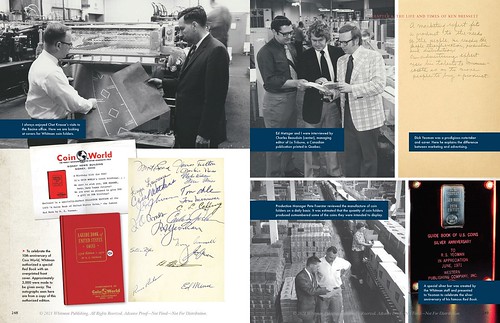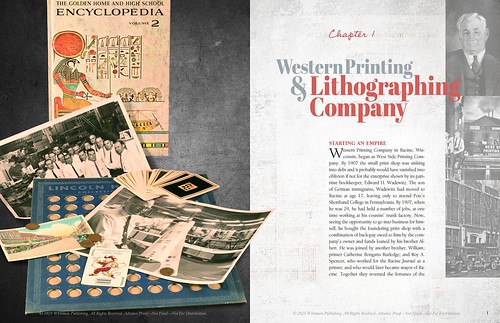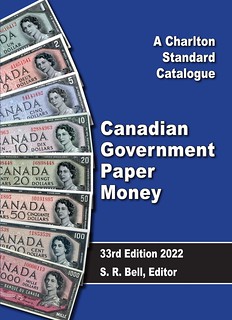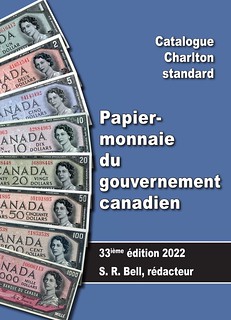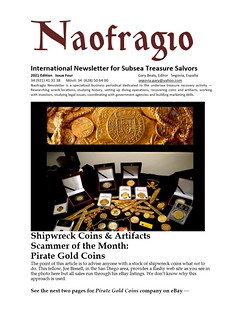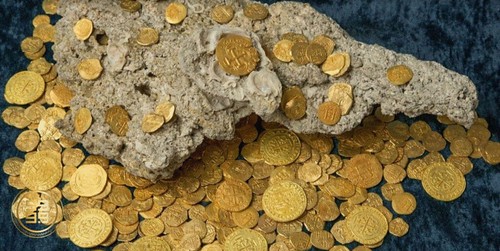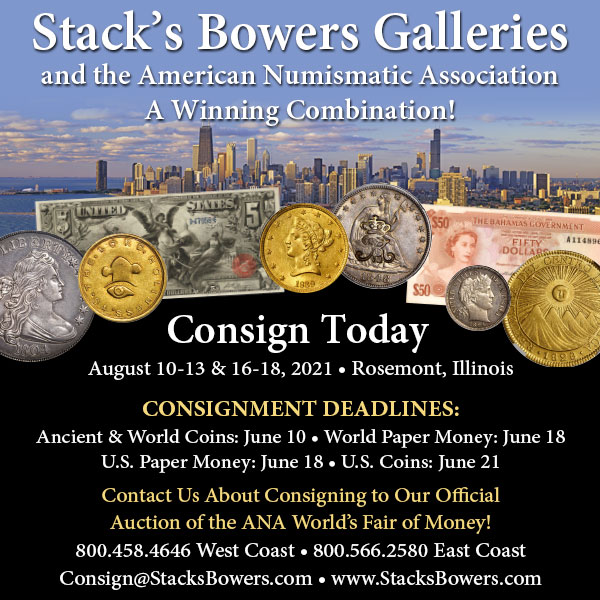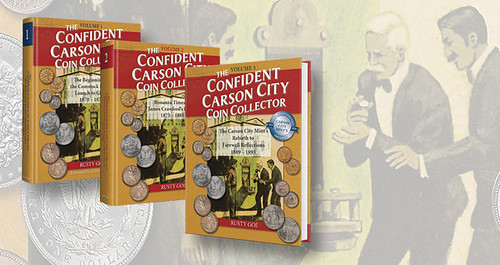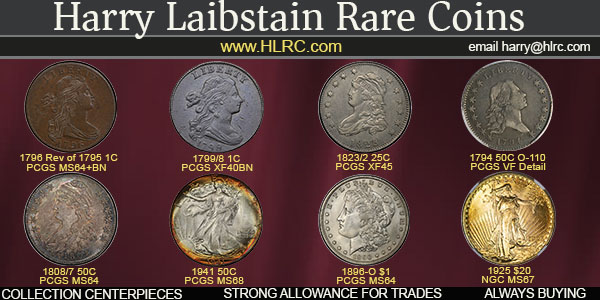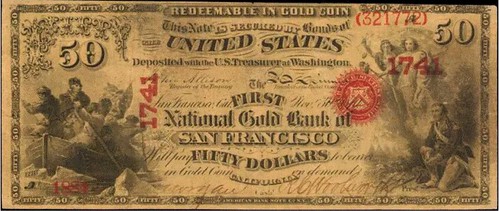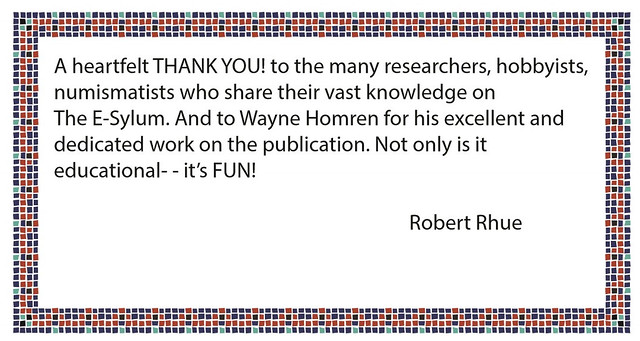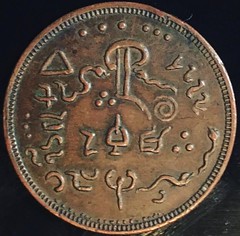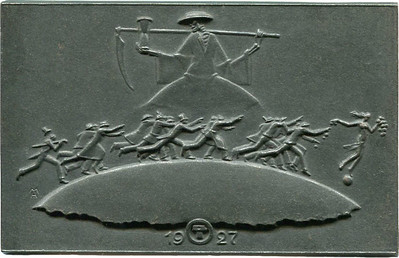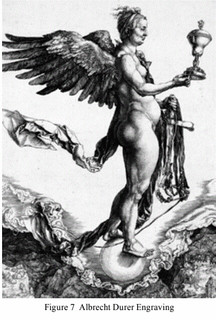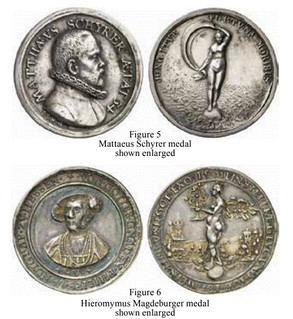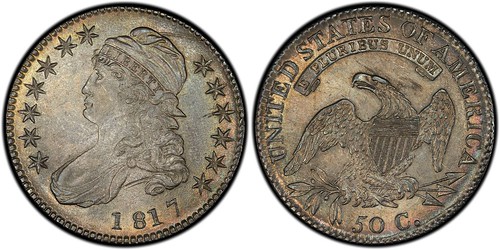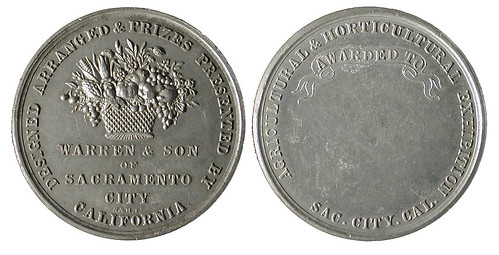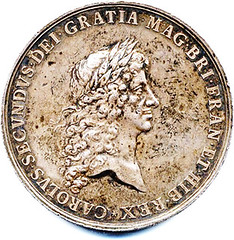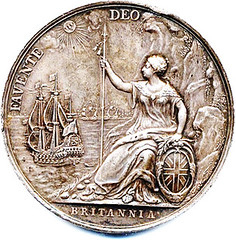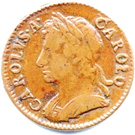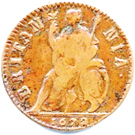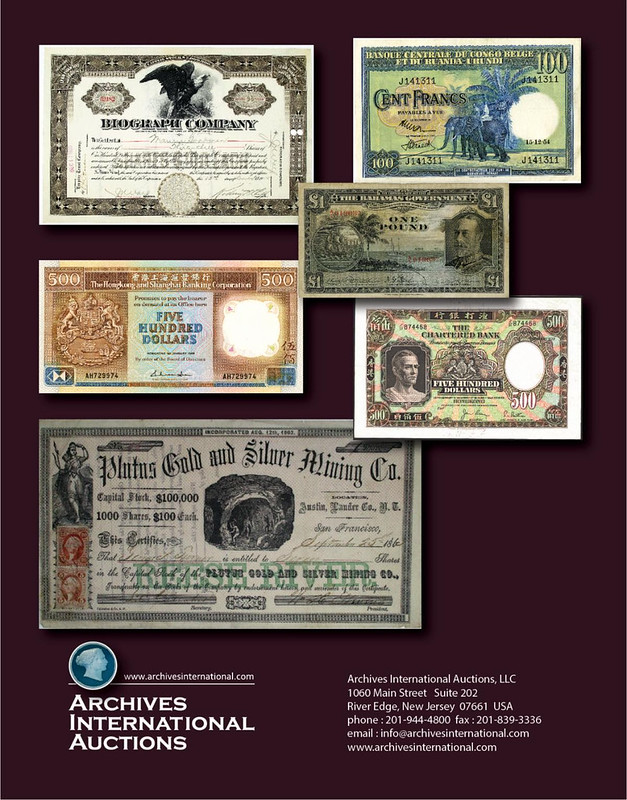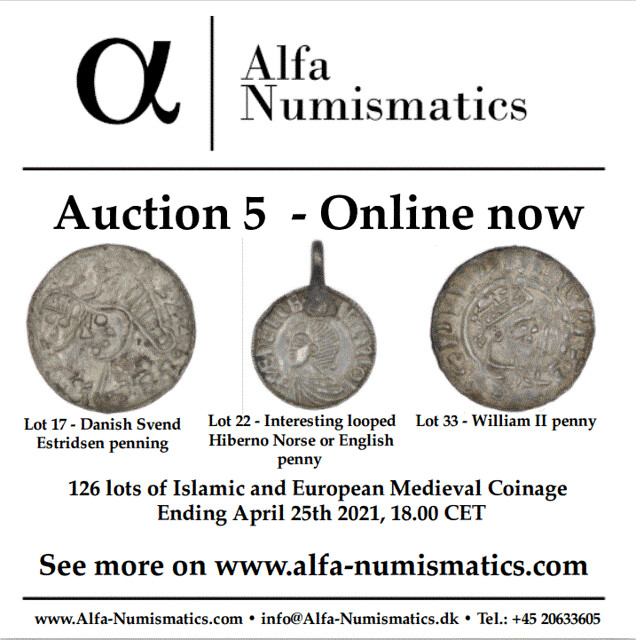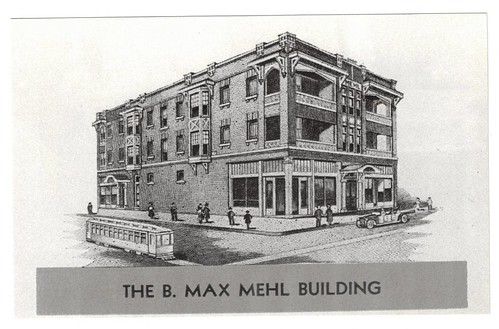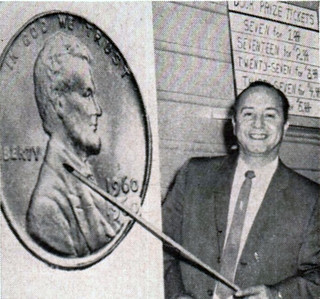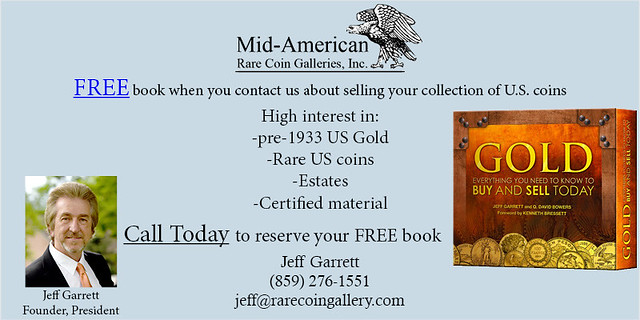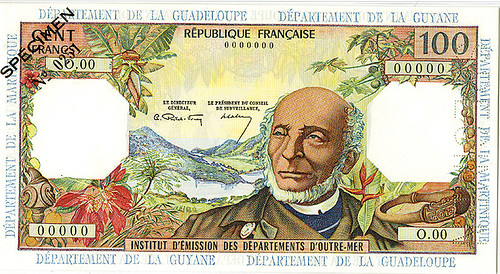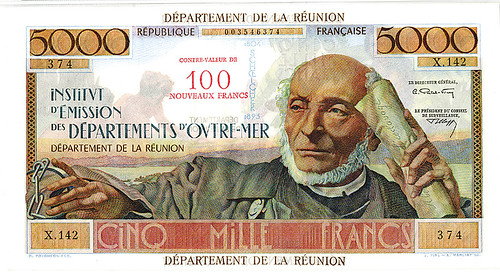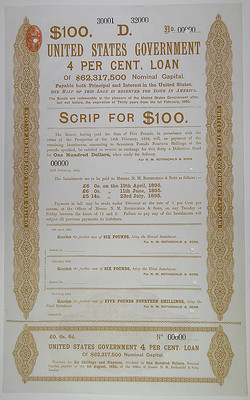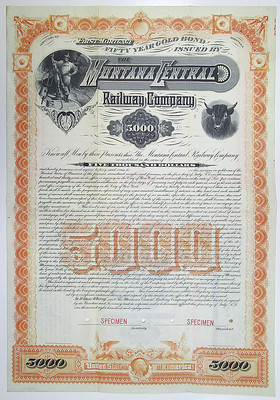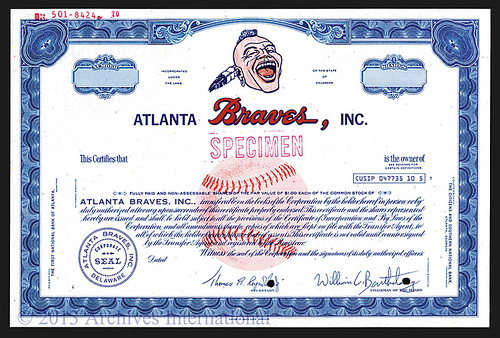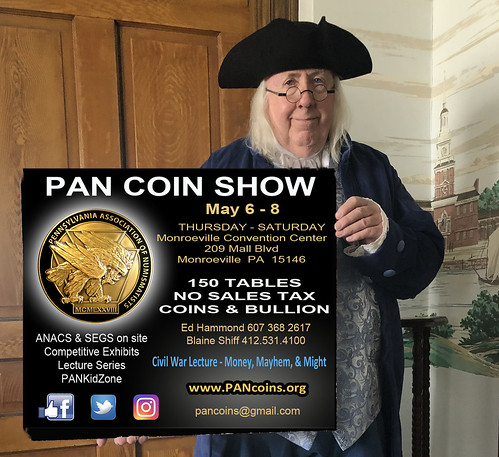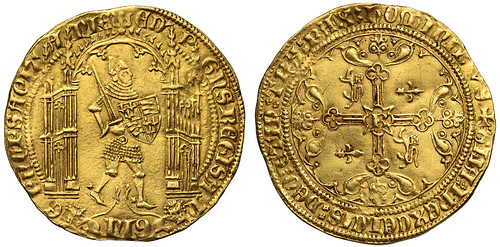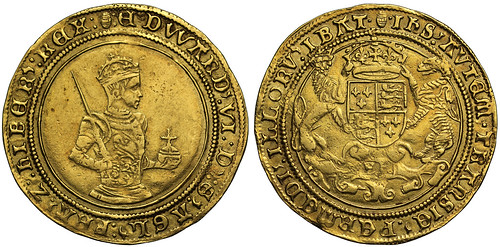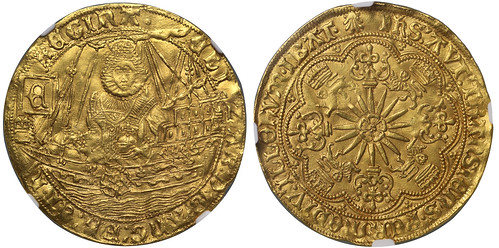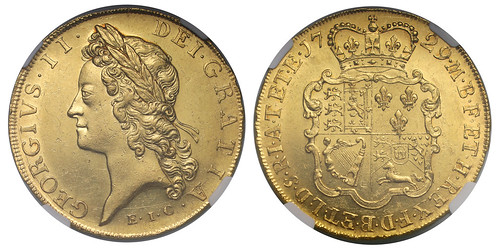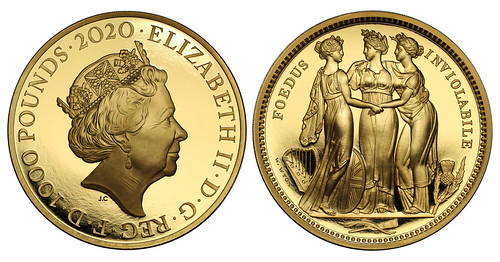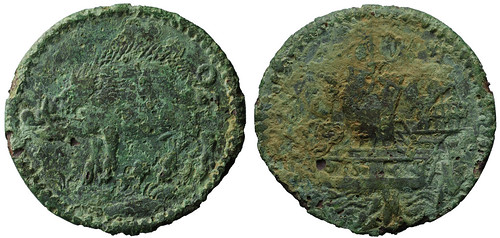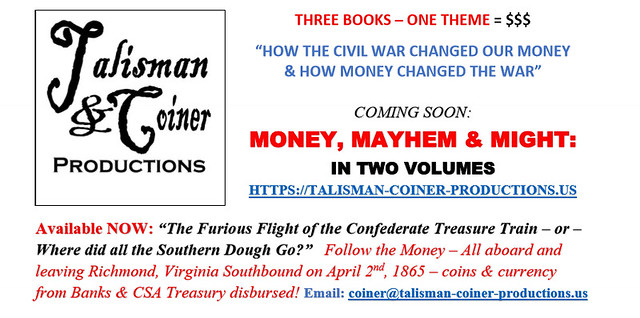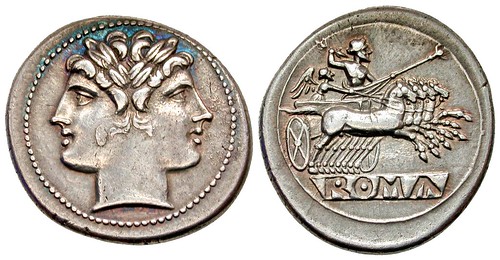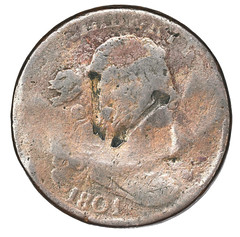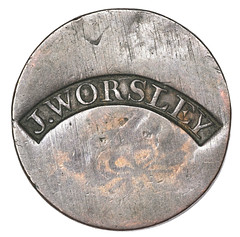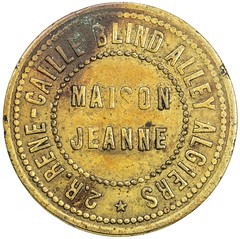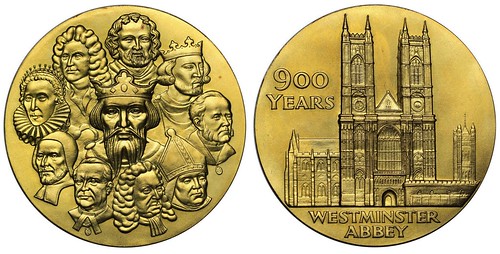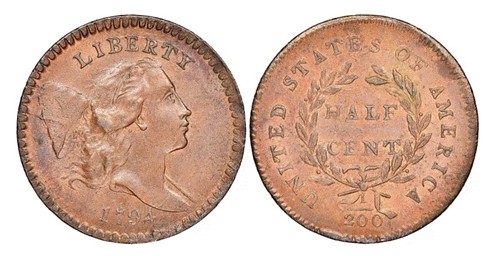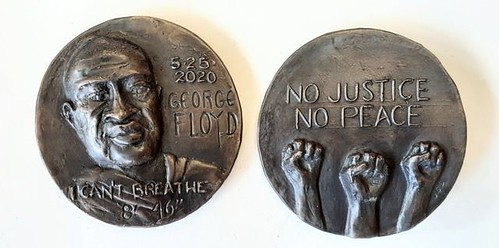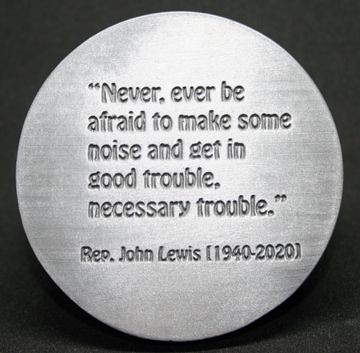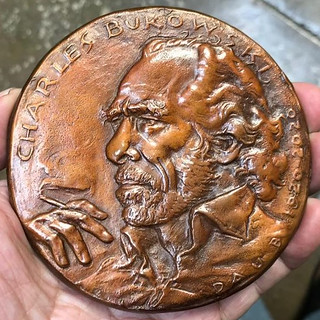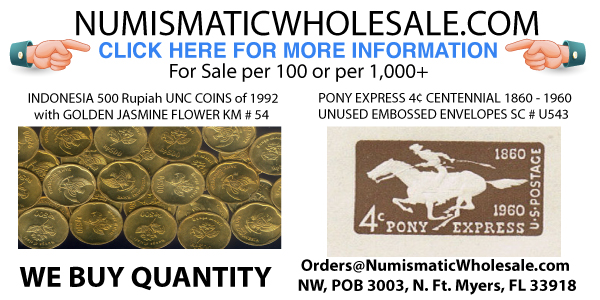
Visit our NBS Sponsors


About UsThe Numismatic Bibliomania Society is a non-profit association devoted to the study and enjoyment of numismatic literature. For more information please see our web site at coinbooks.org SubscriptionsThose wishing to become new E-Sylum subscribers (or wishing to Unsubscribe) can go to the following web page link MembershipThere is a membership application available on the web site Membership Application To join, print the application and return it with your check to the address printed on the application. Print/Digital membership is $40 to addresses in the U.S., and $60 elsewhere. A digital-only membership is available for $25. For those without web access, write to: Charles Heck, Treasurer AsylumFor Asylum mailing address changes and other membership questions, contact Chuck at this email address: treasurer@coinbooks.org SubmissionsTo submit items for publication in The E-Sylum, write to the Editor at this address: whomren@gmail.com BUY THE BOOK BEFORE THE COINSale Calendar |
- WAYNE'S WORDS: THE E-SYLUM APRIL 18, 2021
- NEW BOOK: A PENNY SAVED
- NEW BOOK: STRIKING GOLD IN ALASKA, 7TH EDITION
- NEW BOOK: CANADIAN GOVERNMENT PAPER MONEY
- NEW PERIODICAL: THE NAOFRAGIO NEWSLETTER
- ARTICLE: COIN WEAR
- BOOK REVIEW: CONFIDENT CARSON CITY COLLECTOR
- BOOK REVIEW: GUIDE BOOK OF U.S. PAPER MONEY
- GLENDINING AUCTION SALE CATALOGS ON NNP
- VIDEO: PAPER MONEY AT COLLECTORAMA 2021
- THE MYSTERIOUS WHITEHEAD & HOAG TOKEN
- MORE ON DIE VARIETIES
- WARREN & SON, SACRAMENTO
- NOTES FROM E-SYLUM READERS: APRIL 18, 2021
- VOCABULARY TERM: DIE STAMPED, DIE STRUCK
- JOHN HENRY MATTHEWS (1808-1870)
- B. MAX MEHL, FORT WORTH MARKETING WHIZ
- NEW NLG EXECUTIVE DIRECTOR CHARLES MORGAN
- THE NUMISMATIC LITERARY GUILD MISSION
- ICTA REBRANDS AS NATIONAL COIN & BULLION
- MPC FEST XXII/2021 REPORT
- ARCHIVES INTERNATIONAL AUCTION 66
- SOVEREIGN RARITIES LONDON AUCTION 3
- NUMISMATIC NUGGETS: APRIL 18, 2021
- LORD ST. OSWALD 1794 HALF CENT REAPPEARS
- 2021 AMSA MEDAL OF THE YEAR WINNERS
- 2020 IBNS BANK NOTE OF YEAR AWARD
- MAGNET FISHERS FIND SAFE WITH STOLEN COINS
- OLD BUILDING YIELDS GOLD HOARD
- LOOSE CHANGE: APRIL 18, 2021
Click here to read the thin version on the web
Click here to subscribe
Click here to access the complete archive
To comment or submit articles, reply to whomren@gmail.com
Content presented in The E-Sylum is not necessarily researched or independently fact-checked, and views expressed do not necessarily represent those of the Numismatic Bibliomania Society.
WAYNE'S WORDS: THE E-SYLUM APRIL 18, 2021
 New subscribers this week include:
Robert Staub, courtesy Ken Bressett;
Greg Cheek, and
Alberto Maia.
Welcome aboard! We now have 6,641 subscribers.
New subscribers this week include:
Robert Staub, courtesy Ken Bressett;
Greg Cheek, and
Alberto Maia.
Welcome aboard! We now have 6,641 subscribers.
Thank you for reading The E-Sylum. If you enjoy it, please send me the email addresses of friends you think may enjoy it as well and I'll send them a subscription. Contact me at whomren@gmail.com anytime regarding your subscription, or questions, comments or suggestions about our content.
This week we open with three new books, a new periodical, two reviews, updates from the Newman Numismatic Portal, and more.
Other topics this week include the Red Book, B. Max Mehl, the Numismatic Literary Guild, MPC Fest, auction previews, and annual award winners, including the Banknote of the Year.
To learn more about placer gold tokens, Canadian paper money, treasure salvage, coin wear, Carson City coinage, Fortuna, Charles Morgan, Lee Martin, the morality police, magnet fishing, the George Floyd medal, and the Westminster Abbey Gold Medal, read on. Have a great week, everyone!
Wayne Homren
Editor, The E-Sylum
NEW BOOK: A PENNY SAVED
Here's a new book for coin collectors and numismatic bibliophiles alike - Ken Bressett's book on R. S. Yeoman and the ubiquitous Red Book. -Editor
A Penny Saved: R.S. Yeoman and His Remarkable Red Book
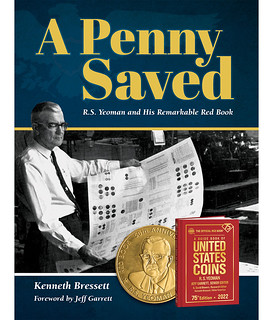 Whitman Publishing announces the upcoming release of A Penny Saved: R.S. Yeoman and His Remarkable Red Book, by Kenneth Bressett. The 352-page hardcover volume will debut in summer 2021, available from booksellers and hobby shops nationwide. In the meantime, it is available for preorder (including at www.Whitman.com and online bookstores).
Whitman Publishing announces the upcoming release of A Penny Saved: R.S. Yeoman and His Remarkable Red Book, by Kenneth Bressett. The 352-page hardcover volume will debut in summer 2021, available from booksellers and hobby shops nationwide. In the meantime, it is available for preorder (including at www.Whitman.com and online bookstores).
The hobby's popular "Red Book"—officially titled A Guide Book of United States Coins—is celebrating its 75th edition this year. In A Penny Saved, the Red Book's editor emeritus, Kenneth Bressett, presents a history of the groundbreaking book and a biography of author R.S. Yeoman, who helped ignite a boom in coin-collecting starting in the 1930s and 1940s by promoting innovations including coin boards, folders, and new books. He tells the story of publishing giant Western Printing & Lithographing Company and follows the development of its offshoot, Whitman Publishing, from 1916 to today. Bressett, who worked alongside Yeoman, also shares his own life story in and out of numismatics. Both men have left indelible imprints on the hobby and on publishing in the United States.
Collectors have used the Red Book for generations, relying on its accurate and up-to-date coin prices, mintage data, photographs, technical specifications, and historical information. It is one of the most popular nonfiction books in the history of American publishing, with more than 25 million copies sold since the first edition debuted in 1946.
The Red Book revolutionized coin collecting by presenting, for the first time, an impartial, professional catalog of average prices dealers were charging for every U.S. coin. It made the hobby accessible to people of all ages, interests, and budgets.
 In A Penny Saved, Ken Bressett has compiled never-before-released documents from the Whitman Publishing archives. He also shares a treasure trove of family photos, corporate memorabilia, and personal recollections about the Red Book and the coin dealers, collectors, researchers, and others who have made it so remarkable.
In A Penny Saved, Ken Bressett has compiled never-before-released documents from the Whitman Publishing archives. He also shares a treasure trove of family photos, corporate memorabilia, and personal recollections about the Red Book and the coin dealers, collectors, researchers, and others who have made it so remarkable.
The book's title derives from Benjamin Franklin's famous aphorism "A penny saved is a penny got." It also reflects Yeoman's story of his first coin board, which he created in 1916 with a jackknife and a piece of cardboard to save an 1894 Indian Head cent he had earned on his newspaper route for the Evening Wisconsin. Twenty years later, during the Great Depression, Yeoman would help launch numismatics into a national craze by marketing and selling cardboard holders for sets of coins collected from pocket change.
A Penny Saved: R.S. Yeoman and His Remarkable Red Book
By Kenneth Bressett; foreword by Jeff Garrett.
ISBN 0794849016. Hardcover, 8.5 x 11 inches, 352 pages, full color.
Retail $39.95 U.S.
https://whitman.com/a-penny-saved-r-s-yeoman-and-his-remarkable-red-book/
NEW BOOK: STRIKING GOLD IN ALASKA, 7TH EDITION
Dick Hanscom of Alaska Rare Coins has published a new edition of his book on the nuts and bolts of making tokens from placer gold. For more information, contact Dick at akcoins@mosquitonet.com . -Editor
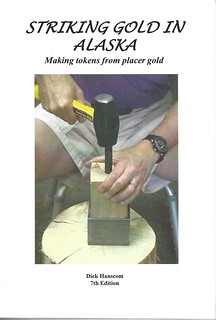 I am pleased to announce the publication of the 7th edition of my book "Striking Gold in Alaska, Making tokens from placer gold."
I am pleased to announce the publication of the 7th edition of my book "Striking Gold in Alaska, Making tokens from placer gold."
Why another edition? Well, the 6th edition is nearly sold out, and because I can.
However, there is new information in this edition. The 6th edition was 221 pages, while the new 7th edition is 258 pages.
There are new techniques and improved techniques. There are even new procedures for new products.
It tells you what I have been up to since 2017 - two trips to England (why is that in there?), Russian wire money, new silver products and other adventures in minting.
Of course there is an up to date description of all the gold tokens I have made since 2017, by my count 11 more 1 DWT tokens. But there are also 1/10 and 1/2 oz. gold tokens.
We take a look at what "smallforest" is doing, and equipment from Ukraine for hand striking tokens.
And there are hints of what is in store for 2021 and later.
For your numismatic education, we look at the Ansell Sovereign, and how this relates to what I am doing.
This 7th edition is available for $20 via media mail and $22 via priority mail from:
Alaska Rare Coins
551-B Second Ave.
Fairbanks, AK 99701
THE BOOK BAZARRE
NEW BOOK: CANADIAN GOVERNMENT PAPER MONEY
There's a new edition of the Charlton Standard Catalogue of Canadian Government Paper Money available in both English and French versions. Here's information from the Trajan Media coin and stamp supplies site. -Editor
2022 CHARLTON STANDARD CATALOGUE CANADIAN GOVERNMENT PAPER MONEY
$39.95
NOW AVAILABLE! Charlton Standard Catalogue of Canadian Government Paper Money Catalogue 2022 – 33rd Edition.
ENGLISH ISBN – 978-0-88968-427-0
FRENCH ISBN – 978-0-88968-428-7
EDITOR – S. BELL
For more information, or to order, see:
2022 CHARLTON STANDARD CATALOGUE CANADIAN GOVERNMENT PAPER MONEY
(https://coinstampsupplies.com/product/2022-charlton-standard-catalogue-canadian-government-paper-money/)
NEW PERIODICAL: THE NAOFRAGIO NEWSLETTER
Gary Beals of Segovia Spain recently launched a new publication on shipwreck coins. Naofragio is an international newsletter for subsea treasure salvors. He provided this great introduction for E-Sylum readers. Thanks! -Editor
as we enter the golden age of shipwreck recovery
Thousands of coins are missing from our collections. And hundreds of tons of gold coins, and thousands of tons of silver coins will be recovered from the world's oceans in the next few years. The result should be more affordable scarce coins, each with a fascinating story to tell of its journey from a sunken galleon into a collector's hands. Simple ‘supply and demand' theories about what will occur in the years ahead is not the answer. Could the huge addition of coins create thousands of type set collectors of Colonial Spanish American coins?
Some of the coins collectors are missing in their collections are on the bottom of the world's oceans. Storms, earthquakes, crime, navigational errors, and explosions aboard ships over the last four centuries caused this. That historical treasure turns out to be billions of dollars worth of gold and silver coins hidden under sand, mud and coral heads.
We can now move past the daydreams and endless chats about how much was lost at sea. We can realistically discuss what might be found. Today all the elements of recovering coins from wrecks are in place. High technology supported underwater equipment has proven itself. Far more serious historical research on treasure wrecks is now being done as the first step in a new recovery process. Governments have become more cooperative about recovering and displaying lost history. There is now a better understanding of the important role archeologists pay in uncovering and studying shipwrecks. And coin collectors are enthusiastic about a wide range of numismatic items coming on the market without overpriced hype.
We all were impressed with the amazing scientific and industrial techniques used to find and bring up the thousands of gold coins and ingots from the SS Central America — and that was 36 years ago. Think about the mobile phone and television set you owned in 1985 and the ones you have now. Improvements like that also taken place in the technology of treasure search and recovery on the world's seabeds.
You paid much less for the phone and television you have now than the ones you had three decades ago. Correspondingly, you may also pay less for the recovered gold and silver coins in the future. Technology can now bring up more gold and silver from the seabed faster and safer at a lower cost. There will be so many treasure wrecks recovered that the coins we want in our collections may well cost less than the heavily hyped prices of the past.
The millions of coins lost in shipwrecks are a small fraction of the amount of wealth that successfully traveled from one point of the globe to another. Documents on sailing ships listed chests of colored gemstones and diamonds, thousands of pearls, magnificent bronze cannons, Ming porcelain and other artifacts made of silver and gold. Wrecks with such treasure are not the subject of this article — unless a few tons of desirable coins are also part of the cargo. We numismatists are tracking only lost coins here — and lots of them.
The Spanish mined more than 500,000 ounces of gold and more than five billion troy ounces of silver in the New World according to some studies. The Portuguese discovered that Brazil had tons of gold in the 1700s and set about getting as much of it as possible to Lisbon. There were always official tallies of the treasure as it was moved from one place to another. And the unregistered contraband gold and silver that was mined, smelted, smuggled and also lost makes up another huge number.
The spark for this new digital publication came from veteran ocean treasure hunter Bill Warren. Bill and I have been in contact since early this year and his enthusiasm for going after treasures aboard sunken Manila galleons in the Philippines got me fired up. As we talked I wondered how much effort it takes to assemble a wreck recovery team and get underway. As I continue my research on Hispanic coins I am learning more about that process daily.
There is a need for an information exchange in the fields surrounding treasure salvors. Divers and salvor firms want to better understand the history of the coins they recover. They should have numismatists handy who can help them with that. On the horizon we can see national governments recognizing that they must partner with trustworthy treasure salvors to harvest the huge wealth just off their shores.
I think there is still a misunderstanding about coins as artifacts. A new shipwreck museum in Spain now has the 500,000 bust type 1803 or so 8 reales coins the Odyssey company salvaged and surrendered from the Nuestra Señora de los Mercedes a few years ago. But the government thinks all of the coins should be kept as museum artifacts. Ridiculous — keep 10,000 or 20,000 so to display and sell the rest — they are as common as brown shoes. Use those thousands of ordinary coins to pay for an even better museum.
Archeologists are the most patient people in the world, waiting decades to open key digs. But they need to realize silver cannot sit in salt water infinitely. Divers must show they are meticulous in their artifact recovery efforts and willing to be good partners with archeologists and historians.
Salvors need to appreciate museum managers and vice-versa. Treasure recovery teams should support local and national museums in the areas where they work.
Integrity must prevail. There have been far too many examples of bad behavior in the treasure salvor field in the last few decades. We will be discussing these criminal failings in coming issues. The term ‘mail box' should never appear in the treasure salvor business unless discussing the U.S. Postal Service.
Many a dive group has had to wait months or years for government approvals to work a wreck site – and even to be turned down. What are the tricks for speeding up the process without archeological losses? How do we inspire government leaders at various levels to work with us? (And bribes are absolutely out of the question.) We will investigate and write about partnering with governments — even corrupt ones — in the months to come.
I want to learn about how treasure recovered from shipwrecks gets to the coin markets. One of my goals would be to help salvors better understand how the numismatic field works. The non-numismatic market could harm things for serious collectors. When someone pays too much for a coin from a shipwreck a new collector is not being created. If there is a mishandling of huge amounts of recovered shipwreck coins the hobby will not grow. This and other aspects of marketing shipwreck coins endangers the need for new collectors in the years ahead. I am eager to talk to all sorts of people in various fields to see what positive changes can accompany the discovery of lost coins.
Puffery, hype and silly nonsense surrounds the coins many shipwreck treasure salvors sell to market. It is time to get real just how much extra value — shown as a price — a coin gains coming from the wreck of Nuestra Señora de Quien Sabe. This will be more and more the case and lost wreck after lost wreck has its treasure recovered. The most common form of shipwreck treasure are gold and silver coins. All any national museum needs is a few hundred coins to document a wreck found off its country's coast. All the other thousands can be split between the government and the salvor company.
For more information, contact Gary at segovia.gary@yahoo.com . Subscriptions are free for now. -Editor
ARTICLE: COIN WEAR
Economist, author and E-Sylum contributor François R. Velde co-authored a new paper in the journal Physica A: Statistical Mechanics and its Applications titled Coin wear: A power law for small shocks. Interesting for those of us who geek out on both coins and math. -Editor
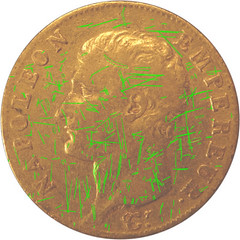 Abstract
Abstract
The study of coin wear is useful for numismatics and economics. We examine a 19th century gold coin with a SEM and show that weight loss is due to a large number of small shocks that follow a truncated power law. Under the compound Poisson process we propose, weight loss over time is nearly deterministic in the proportion of time actually spent in circulation.
Introduction
The study of wear, now a fully fledged branch of physics [1], dates back to the late eighteenth century. The first studies, on gold and silver coins, were carried out by the most prestigious scientists: Isaac Newton [2], Henry Cavendish, Jean-Baptiste Dumas, Jean-Charles de Borda, Joseph-Louis Lagrange, Antoine Lavoisier. The interest was practical. Governments wanted to measure wear on coinage to estimate the cost of replacing worn coins with new ones. Interest waned after World War I brought the end of the gold standard and coins ceased to be made from precious metals. The subject nevertheless remains of interest for numismatics and economics: if wear is subject to regular laws, inferences can be made about the age of an undated coin or about the intensity of use (velocity).
To read the complete article (available until May 30, 2021), see:
Coin wear: A power law for small shocks
(https://www.sciencedirect.com/science/article/pii/S037843712100220X)
BOOK REVIEW: CONFIDENT CARSON CITY COLLECTOR
Bruce Thayer submitted this review of Rusty Goe's new book. Thanks! -Editor
 Dear Friends and Carson City coin enthusiasts,
Dear Friends and Carson City coin enthusiasts,
Fifteen years ago, I telephoned a coin dealer in Nevada to enquire about an 1878 CC quarter for sale on the dealer's web site. I was a total numis-novice at the time, and was considering the coin for a US coin type set that I had recently started. The lady answering the phone asked me to wait a moment while she sought someone named "Rusty", who would answer my questions.
Little did I realize that "Rusty", who patiently answered my neophyte questions, was among the world's leading authorities on Carson City coins. That single phone ultimately enriched my life and opened the door to the fascinating subject of Carson City minted coins and their important place in American history.
Over the past 15 years, I have had the honor of working closely with Rusty Goe who has helped me patiently select and acquire every one of the 96 date-denominations (AU-53 Avg) in my collection, utilizing Rusty's extremely high, quality standards, regardless of the grade.
I'm writing to let everyone know that after ten years of research and hands-on analysis of hundreds, if not thousands of individual coins, Rusty Goe has finally completed the long-awaited update of his popular book, The Mint on Carson Street. Rusty's 2,300-page, three-volume masterwork is entitled, The Confident Carson City Coin Collector. This is easily the most comprehensive historical review ever completed about the region, its people, the Carson City mint itself and the fabulous coins stamped with a bold CC.
Organized and presented in a unique and interesting way, The Confident Carson City Coin Collector ultimately reads like a story, while delivering comprehensive facts, information and insights to serve even the most detailed numismatist. David Bowers wrote;
The word is out in the numismatic community that Rusty's book has finally been completed and is available for sale. When I called to congratulate Rusty, I learned that 1,025 sets had been printed, of which 60% are sold already. No more will be printed. Several big numismatic organizations, such as Heritage Auctions, have purchased multiple sets, which I'm guessing they will give to their top clients. I bought two sets myself, one for my home and one for my office library.
The full, three volume, 2,300-page set is selling for $299, which is less than used copies of the 536-page, The Mint on Carson Street sells for on Amazon, or about the same as one would pay for a heavily worn, common date, CC Morgan silver dollar!
The Confident Carson City Coin Collector can be purchased at the below site, or on Amazon.com.
https://www.southgatecoins.com/books-supplies
I have absolutely no financial interest in this publication and Rusty Goe has not asked me to write this letter. I'm merely reaching out to fellow Carson City coin enthusiasts with this recommendation to buy a copy of this important three-volume reference before they are gone. I have no doubt the price to acquire The Confident Carson City Coin Collector will double or triple once the remaining sets are gone.
To read the earlier E-Sylum articles, see:
NEW BOOK: CONFIDENT CARSON CITY COIN COLLECTOR
(https://www.coinbooks.org/v24/esylum_v24n05a04.html)
BOOK REVIEW: CONFIDENT CARSON CITY COLLECTOR
(https://www.coinbooks.org/v24/esylum_v24n11a06.html)
BOOK REVIEW: GUIDE BOOK OF U.S. PAPER MONEY
Mike Thorne published a nice review in Numismatic News of Whitman's sixth edition of A Guide Book of United States Paper Money. I just had my copy of the book out yesterday, and it's a quite useful volume. Here's an excerpt of the review - see the complete article online. -Editor
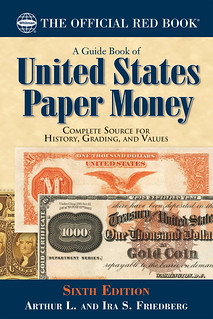 Going through the 6th edition of Whitman's A Guide Book of United States Paper Money, I can begin to see what the fuss over paper money is all about. After all, virtually any 19th century banknote is more attractive than the average coin featuring the same central motif. If you think that the Indian on the Buffalo nickel is strikingly attractive, take a gander at the $5 "Indian Chief Note" featuring the chief colloquially known as Running Antelope. Of course, the Chief has a much larger canvas than the fellow on the nickel. It's that larger canvas that makes the images on banknotes so striking.
Going through the 6th edition of Whitman's A Guide Book of United States Paper Money, I can begin to see what the fuss over paper money is all about. After all, virtually any 19th century banknote is more attractive than the average coin featuring the same central motif. If you think that the Indian on the Buffalo nickel is strikingly attractive, take a gander at the $5 "Indian Chief Note" featuring the chief colloquially known as Running Antelope. Of course, the Chief has a much larger canvas than the fellow on the nickel. It's that larger canvas that makes the images on banknotes so striking.
The authors of this guide book are a pair of brothers, Arthur and Ira Friedberg, who have been in the numismatic business for more than 30 years. Both joined the family business (Coin & Currency) after finishing college. Among other activities, Arthur and Ira have stayed busy co-authoring such popular works as Gold Coins of the World, Paper Money of the United States, and Appraising and Selling Your Coins.
The guide book has a fairly lengthy introduction penned by David Ganz, an attorney and former president of the ANA (1993-1995). Ganz is the author of more than 14 books and thousands of numismatic articles in the past half century.
As you would expect, Ganz includes a brief section on grading U.S. currency. There are text descriptions only, however. Perhaps a future edition might include a brief pictorial grading guide.
Ganz closes the introduction with a listing of the types of U.S. currency. He starts with the rarest issues of Interest Bearing Notes issued because of financial emergencies brought about by the Civil War and ends with our present day Federal Reserve Notes.
As you'll find in guide books of U.S. coins, the banknotes are listed by denomination, beginning with the $1 note all the way to the unimaginable $10,000 notes (unimaginable to me, at any rate). Beyond the $10,000 notes, there are brief "chapters" that examine Fractional Currency, Treasury Notes of the War of 1812, Encased Postage Stamps, and Error Notes.
I checked the publisher (whitman.com) and found that the book was out of stock, which perhaps tells us about the demand for this item.
I contacted Dennis Tucker at Whitman Publishing who reminded me that Mike and I are both out of date - there's a newer 7th edition which had sold out as well, but there's good news about that. -Editor
Dennis writes:
"I appreciate Mike Thorne's review and observations on the Guide Book of United States Paper Money. The seventh edition has been out for a few months and it's one of several Whitman titles that have recently sold out of their initial print runs. We've got it back on press, and collectors should now be able to order a copy at the Whitman web site (https://whitman.com/a-guide-book-of-united-states-paper-money-7th-edition/) or from their favorite hobby shop or retail bookseller.
"I asked Art Friedberg to share some thoughts on the market for U.S. paper currency. He said, "Despite the fact that we are still in the midst of the COVID-19 pandemic, there is no lessening of the enthusiasm collectors have for United States paper money. Expensive notes are still setting records, and a plentiful supply of the more common material provides a field day for those wanting to expand their collection.""
To read the complete article, see:
Review of Paper Money Guide Book
(https://www.numismaticnews.net/paper-money/review-of-paper-money-guide-book)
To read the earlier E-Sylum articles, see:
NEW BOOK: GUIDE BOOK OF U.S. PAPER MONEY 6TH ED.
(https://www.coinbooks.org/v22/esylum_v22n02a04.html)
NEW BOOK: GUIDE BOOK OF U.S. PAPER MONEY 7TH ED.
(https://www.coinbooks.org/v23/esylum_v23n32a03.html)
GLENDINING AUCTION SALE CATALOGS ON NNP
The latest additions to the Newman Numismatic Portal are the post-1923 Glendining sale catalogs. Project Coordinator Len Augsburger provided the following report. -Editor
Glendining Auction Sale Catalogs on Newman Portal
 Important American numismatic material frequently shows up in European sales, as demonstrated by a 1935 Glendining's auction sale catalog. This sale included 262 lots of American items including a good variety of federal and colonial pieces. Four plates will support pedigree research of the frontline examples. Newman Portal previously scanned the Glendining's catalog run from 1901-1923 and is now proceeding with the remainder of these UK sales.
Important American numismatic material frequently shows up in European sales, as demonstrated by a 1935 Glendining's auction sale catalog. This sale included 262 lots of American items including a good variety of federal and colonial pieces. Four plates will support pedigree research of the frontline examples. Newman Portal previously scanned the Glendining's catalog run from 1901-1923 and is now proceeding with the remainder of these UK sales.
Thanks to John Millensted of Bonham's (successor to Glendining) for granting permission to scan these catalogs, NNP supporter Eric Hodge for working with Glendining, ANS Librarian David Hill for coordination with Internet Archive, and Lara Jacobs of Internet Archive who performs scanning activities at the ANS library.
Image: Pine Tree Shilling, Crosby 5, lot 168 from the Glendining March 21, 1935 sale
Link to Glendining's 1935 Catalogue of Early American Coins:
https://archive.org/details/catalogueofearly00glen/page/n5/mode/2up
Link to Glendining's auction sale catalogs on Newman Portal:
https://nnp.wustl.edu/library/auctioncompanydetail/512958
VIDEO: PAPER MONEY AT COLLECTORAMA 2021
These are selections from the David Lisot Video Library that feature news and personalities from the world of coin collecting. David has been attending coin conventions since 1972 and began videotaping in 1985. The Newman Numismatic Portal now lists all David's videos on their website at:
https://nnp.wustl.edu/library/multimediadetail/522852
Here's one on paper money seen at Collectorama 2021. -Editor
Cool US and World Currency at Collectorama 2021!
VIDEO: 13:35.
 David Lisot, Interviewer, CoinTelevision.com with John Bremer, Robert Calderman and Larry Garvin. February 18, 2021.
David Lisot, Interviewer, CoinTelevision.com with John Bremer, Robert Calderman and Larry Garvin. February 18, 2021.
David Lisot brings paper money to his audience by interviewing paper money experts that show both large and small size notes. Topics range from US to world bank notes including the Legal Tender "Woodchopper" 1869 PMG64, 1878 PMG64, & 1907 PMG64 $5, $500 1934 Legal Tender, 1923 and 1928 Silver Certificate PMG64 , 1928 Federal Reserve Serial #4 PCGS66PPQ, 1928 Federal Reserve PMG64 "Star Note", German East Africa 5 Rupien 1906 PMG40, Russia 100 Kopeks 1910 "Catherine the Great", British Caribbean Territories $1 Queen Elizabeth 1963 PMG45, and Chinese reproductions from 1950's.
An excerpt of the video is available for viewing on the Coin Television YouTube Channel at:
https://www.youtube.com/watch?v=okvyv8xp3bI
THE MYSTERIOUS WHITEHEAD & HOAG TOKEN
Readers commented on the odd Whitehead & Hoag token Len Augsburger asked about last week. -Editor
Joel Anderson writes:
"I had similar pieces in a collection of Magician's tokens that I handled about 25 or 30 years ago. Alas, I do not recall any of the details. Some of the pieces in the collection had nonsensical legends in order to make them look exotic. Someone might explore magician token references."
Jud Petrie writes:
"I have also been intrigued by this token for many years. This 'Eve' token is in both copper and brass.
"Despite its longtime association with magic tokens it has never been 'officially' attributed as such, although many include it in their collections. Personally I can state that two of these tokens were found in a box of assorted magic tokens owned by my great-grandfather, John Petrie, who was in the magic manufacturing business (Petrie & Lewis). P&L was in business from the early 1900's until 1965; he died in 1954. I hope that further information is forthcoming, and am sure that other magic token collectors feel the same."
William Todd writes:
"Regarding the obverse of this token, I would strongly suggest that the image is NOT Eve tempted by the apple, but rather Fate/Nemesis/Fortuna balanced on a ball. Nemesis since ancient Rome has been portrayed with a wheel ("of fate") and since at least the Northern Renaissance (e.g. painter/engraver Albrecht Dürer), depicted as a naked woman standing on a sphere often floating in the air above a land- or cityscape. A Google-search will turn up numerous examples.
"I agree that the arm from the cloud is that of a Deity, but what is it offering? A heart as a love-token? In any case Fate appears to reject it or ignore it.
"There are many numismatic representations of Fate as described above. Here's a photo of a plaquette by German medallist and sculptor Heinrich Moshage from my collection. Fortune at right pursued across the world as Death presides overall."
John Sallay writes:
"I can't tell you much about the mysterious Whitehead & Hoag token, except that the obverse is not "Eve's temptation in the Garden of Eden." Rather, it is the Roman goddess Fortuna, the personification of luck, chance, fate, and fortune. And the arm coming out of the cloud is not the devil, but on the contrary, the arm of God bestowing some gracious gift.
"Unfortunately, I can't help you with the reverse, but to me, a few of the squiggles look like snakes."
John co-authored an article with Peter Olav Pleuss in The MCA Advisory (July/August 2017, pages 31-33) where they discussed the Fortuna iconography as it was used on some late-Renaissance medals. Herre are some images from the article. -Editor
William Todd adds:
"Regarding the reverse, I hope someone will investigate occult signs. I'm no expert in this, but that is what they appear to be. They could be genuine, but they also may be loosely based on some examples without real significance, only added for hocus-pocus effect.
"I look forward to further readers' comments on this interesting piece."
To read the earlier E-Sylum article, see:
A MYSTERIOUS WHITEHEAD & HOAG TOKEN
(https://www.coinbooks.org/v24/esylum_v24n15a07.html)
MORE ON DIE VARIETIES
Regarding his question about the definition of coin varieties, Bill Eckberg wrote:
Brad Karoleff writes:
"If the die itself, the hunk of steel with the design on it, is the same it is the original die MARRIAGE. If it is extensively reworked it is still the SAME die but now in a different STATE or STAGE making the coins minted from it a die STATE or STAGE of the original die MARRIAGE.
"Let's use the 1817 half dollars as an example. We have the Overton 103, the punctuated date, which shows a distinct dot between the 1 and 7. In later die states it disappears. It is still the same marriage of O103, but a different state which does not show the dot (O103a).
"We can also look at the O106. In the earliest die state the marriage comes with the ridge from the top of the cap to the rim on the obverse and a normal reverse. After use the reverse die was severely lapped removing the upper leaf from the olive stem on the reverse creating the single leaf VARIETY. It is still the same MARRIAGE but in a distinct different STATE or STAGE that is highly collected by specialists (O106a single leaf). "
Bill and I like this description. Next up is an additional commentary by John Regitko of Toronto, Canada on what DOESN'T constitute a variety. -Editor
With reference to what is a variety and what is an error, I accumulated many contradictions and errors for my Error & Variety Seminars that dominate the "informational" websites on the Internet. Here are a few examples:
The Coins of the Year Club (COTY) of Saskatoon, Saskatchewan, published the following:
"Error coins are usually a result of a worn out die or a sudden break in a die. Many people think because a coin has grease or nicks in the coin that it is an error. There are many types of errors but you must think of it in terms of rarity, not appearance. The rarest errors are errors that are very difficult to identify, such as the 7 over 8; double mint mark; or double dies."
I don't know about you, but I never had difficulty identifying 7 over 8, double mint marks or double dies. And I never thought that rarity determined what the error is.
COTY also published the following:
"Things like dings, marks or "cuds" as they are known are very common and would never be considered an error by any standard, especially when produced by the millions."
Millions of cuds and dings or marks on a die would indeed be very common!
The Coin Community Forum carried on a discussion about die axis. The Charlton Standard Catalogue of Canadian Coins lists the axis of the Canadian 1992 New Brunswick commemorative quarter two arrows up (normal medallic setup), one arrow up and one down (error 180 degree die rotation set-up), and one arrow up and one sideways (error 90 degree rotation).
To the question from one of their members if these are errors, the response is: "Yes, but the error is so plentiful, it is termed a variety."
I never thought that the number available of a particular inconsistency from normal determines if something is an error or a variety!
Hans Zoell's explanation of why we should not blame the equipment for producing errors would be laughable if he was not serious. Zoel published a number of booklets in the 1960s containing illustrations of errors and varieties with very minimal explanation.
One rant he published in one of his booklets, under the heading "What is an Error?," stated:
"Errors, in reality, are the result of human carelessness, and can not be attributed directly to mechanical malfunction. A machine does not have a brain, and will function only as efficient as the human attendant will care for it. If the attendant or operator does not take proper care of the machine he operates, or faulty parts are contained within, a machine will not function well and is bound to produce faulty products. Therefore we must attribute ‘errors' to ‘human' carelessness and not to the machine, directly."
Zoell's unique reasoning is: "Would you be able to correct the faults by giving a machine a ‘good talking to' to make it understand its wrong doings? I guess not. Why then blame a machine for inefficient production?"
Huh?
With such misinformation out there, no wonder that many collectors have a problem deciding what is an error and what is a variety!
I found the best simple explanation on minterrornews.com about the difference between a variety and error because it included exceptions. For example, although die cracks and brockages could appear on hundreds of coins, there are generally minute differences between strikes due to expansion of the die crack or flattening of the design and are therefore considered errors, not die varieties.
Thanks, everyone. -Editor
To read the earlier E-Sylum article, see:
WHAT CONSTITUTES A DIE VARIETY?
(https://www.coinbooks.org/v24/esylum_v24n15a11.html)
WARREN & SON, SACRAMENTO
Michael Wehner writes:
"Regarding Dave Hirt's question in his commentary on J.N.T. Levick: "There is a token in this sale that I can not identify. It is lot 1056 Warren & Son, Sacramento, tin, size 25. Perhaps our token collector readers can help us identify it. "
"This is most likely one of the agricultural medals that I wrote about in the June 2020 issue of the Medal Collectors of America MCA Advisory. Col. J.L.L.F. Warren issued two sizes - the smaller one, for his 1852 Agricultural and Horticultural Fair is 1.5 inches in diameter or "size 24" in the old catalogs. I suspect that the "size 25" listing came from a slight error in measurement. Almost all of the examples of this medal that I could locate in old catalogs are unawarded.
"I also spoke about Col. Warren at the 1st Newman Numismatic Portal symposium. See Award Medals from the California State Fair and their Precursors (https://nnp.wustl.edu/library/book/588176)
"See above for a picture of the medal in "tin"
Thanks! -Editor
To read the earlier E-Sylum article, see:
MORE ON J.N.T. LEVICK
(https://www.coinbooks.org/v24/esylum_v24n15a15.html)
NOTES FROM E-SYLUM READERS: APRIL 18, 2021
Clifford Mishler on Meeting Prince PhilipClifford Mishler writes:
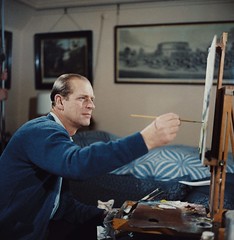 "Reading your ‘numismatic connection" reference to Prince Philip as "president of the Royal Mint Advisory Committee," I thought I might share another related sidelight.
"Reading your ‘numismatic connection" reference to Prince Philip as "president of the Royal Mint Advisory Committee," I thought I might share another related sidelight.
"In 1996 I was accorded the favor of having the opportunity of shaking hands and briefly chatting with Prince Philip when I visited London for the purpose of presenting the British Royal Mint and the United Kingdom with the "Coin of The Year" recognition of their being honored as the producer of the premiere 1994 COTY winner, the "50th Anniversary of the Invasion of Normandy" 50 pence commemorative, which was the work of one of England's most talented sculptors, John Mills. Displayed on my office wall is a sketch of that winning design, which was tendered to me at the time by Mr. Mills."
Marvelous - what a great experience. -Editor
To read the earlier E-Sylum article, see:
NOTES FROM E-SYLUM READERS: APRIL 11, 2021 : Prince Philip, Royal Mint Advisor : 2017 Prince Philip Coin
(https://www.coinbooks.org/v24/esylum_v24n15a14.html)
Dave Schenkman writes:
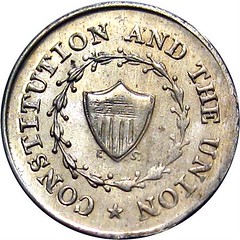 "I've enjoyed reading the postings about J.N.T. Levick. When I taught courses on Civil War era numismatics at the ANA's summer seminars, I always discussed his 1884 sale catalog, and especially the statement in the section of Civil War tokens that "Most of the nickel cards in Mr. Levick's collection are proofs struck to order, and cost in quantity 15 cents at the time." Concerning the large number of silver tokens which were in the sale, it was noted that "all were struck to order."
"I've enjoyed reading the postings about J.N.T. Levick. When I taught courses on Civil War era numismatics at the ANA's summer seminars, I always discussed his 1884 sale catalog, and especially the statement in the section of Civil War tokens that "Most of the nickel cards in Mr. Levick's collection are proofs struck to order, and cost in quantity 15 cents at the time." Concerning the large number of silver tokens which were in the sale, it was noted that "all were struck to order."
Obviously Levick was instrumental in the manufacture of many rare Civil War tokens which now sell for prices that are often thousands of dollars."
What a great collector. I added an image of an R8 Patriotic token in German silver from Steve Hayden's https://civilwartokens.com/ site. -Editor
Pete Smith submitted the entry for J.N.T. Levick from his book American Numismatic Biographies. -Editor
 Levick, Joseph N(apoleon) T(ricot) Collector (ca. 1828 d. 9/7/1908)
Levick, Joseph N(apoleon) T(ricot) Collector (ca. 1828 d. 9/7/1908)
Born in New Orleans, Louisiana. During the Civil War he served as a captain with the New York Volunteers. Married. In 1870 he advertised in the AJN as a banker and broker dealing in government securities, foreign and domestic specie, stocks, bonds, and gold. He also bought and sold rare coins.
In 1866 he proposed a journal for the ANS. This led to publication of the American Journal of Numismatics. He also contributed articles. He was Treasurer of the ANS May 9, 1867, to March 26, 1874.
His collections were included in several auction sales. One sale was scheduled for April 27-29, 1865. Because of the death of President Lincoln, the sale was postponed to May 29.
Pete adds:
"I have never seen his full date of birth. Can any E-Sylum reader provide it?"
Can anyone help? -Editor
To read the earlier E-Sylum article, see:
MORE ON J.N.T. LEVICK
(https://www.coinbooks.org/v24/esylum_v24n15a15.html)
Regarding Harvey Stack's article last week, Harry Cabluck writes:
"The name of the newspaper started/owned by Amon Carter is the Fort Worth Star-Telegram."
Thanks. And the paper is very much still around. See an article elsewhere in this issue about dealer B. Max Mehl excerpted from the paper. -Editor
To read the earlier E-Sylum article, see:
HARVEY STACK'S NUMISMATIC FAMILY, PART 93
(https://www.coinbooks.org/v24/esylum_v24n15a18.html)
George Kolbe writes:
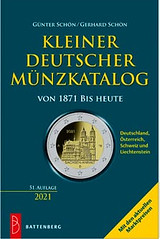 "What a confusing book title: SMALL GERMAN COIN CATALOG. Interpretations abound, including:
"What a confusing book title: SMALL GERMAN COIN CATALOG. Interpretations abound, including:
1) a small format catalogue;
2) a brief catalogue;
3) a catalogue written by a diminutive German;
4) a catalogue written for a diminutive German;
5) a catalogue written about small-sized German coins.
"The list might go on, not even including the catalog vs. catalogue wrinkle, or "until today."
"Mainly, the problem is the translation from an exacting language to an inherently imprecise one, largely attributable here to the computerized rendition."
Indeed. I thought that myself when I wrote that headline, so I'm not surprised someone mentioned it. "Catalog of Small German Coins" (as in Option 5) would have been a much better choice. "Kleiner Deutscher Münzkatalog" wouldn't have cut it for most of our readers. -Editor
To read the earlier E-Sylum article, see:
NEW BOOK: SMALL GERMAN COIN CATALOG
(https://www.coinbooks.org/v24/esylum_v24n15a03.html)
Ken Bressett writes:
"Your recent stories about the Peace of Breda medals brought to mind a story that I wrote some time ago about the Liberty Seated image; it was published in the January 1991 issue of COINS, on pages 50 and 54.
Thanks. Ken kindly forwarded a copy of the article. It traces the figure of Seated Liberty from the Peace of Breda medal through Thomas Simon's Petition Crown and British copper coinage through to the U.S. Seated Liberty design by Christian Gobrecht. Ken also provided these images from the article. Thanks! -Editor
To read the earlier E-Sylum article, see:
THE FONROBERT PEACE OF BREDA MEDAL
(https://www.coinbooks.org/v24/esylum_v24n15a12.html)
Jim Duncan writes:
"Can any of your many contacts provide a reproducible pic of a Monneron 2 Sol pattern piece (that's Hercules / Pyramid)? I'm a collector in NZ who cannot find one on the web. jimchris.d@xtra.co.nz I'd be most grateful."
VOCABULARY TERM: DIE STAMPED, DIE STRUCK
Here's another entry from Dick Johnson's Encyclopedia of Coin and Medal Terminology. -Editor
Die Stamped, Die Struck. Striking a blank of metal with two punches (dies) under pressure and at room temperature. Die stamped or die struck is in contrast to any other metalworking methods of manufacture, as cast, hammered, rolled, forged, or even die-cast. Striking with dies is the traditional method of manufacturing coins and medals since the mid 16th century. Die striking is also called coining (and the piece is coined) when there are two relative flat surfaces with no deep drawing of the surface metal.
Die striking (coining) creates the sharp impression in hard metal suitable for coins, medals, tokens and the similar items discussed in this book. Not all metals are suitable for the blanks for coining (see coinability), however only one metal is suitable for the manufacture of the dies required – they must be made of steel. As coinage technology evolved the method of applying the pressure, by coining presses, has changed. But the end product – coins to circulate – have changed little for centuries (other than design, of course). Although an attempt has been tried twice in history to manufacture coins by roller dies and blanking afterwards (taschenwerke), this process failed both times. In effect, no new basic method of manufacture has been invented to replace die stamping or die striking of preformed blanks. This method is a 400-year old successful technology that appears to continue well into the future.
To read the complete entry on the Newman Numismatic Portal, see:
Die Stamped, Die Struck
(https://nnp.wustl.edu/library/dictionarydetail/515757)
JOHN HENRY MATTHEWS (1808-1870)
Here's another entry from the online draft of John Lupia's book of numismatic biographies. Thanks! This is an excerpt with the full article and bibliography available online. This week's subject is Soda Fountain King John Matthews. -Editor
 John Henry Matthews (1808-1870), was born on December 19, 1808, at Standford, Dingley, Berkshire, England, the son of John Matthews (-1827), and Elizabeth Robinson Matthews (1786-1846).
John Henry Matthews (1808-1870), was born on December 19, 1808, at Standford, Dingley, Berkshire, England, the son of John Matthews (-1827), and Elizabeth Robinson Matthews (1786-1846).
On February 8, 1830, he married Elizabeth Chester (1811-1889) at Bristol, England. They had six children : two daughters and four sons.
On March 2, 1832, he moved to New York City, New York.
In 1832, he designed, patented and issued the soda water fountain.
In 1863, he issued a store card, obverse : right profile of Amphitrite with a dolphin swimming in the field before her, reverse: advertisement of John Matthews. This store card is usually identified and catalogued as a Civil War token as Fuld NY 630 AU-1a.
In 1865, he retired from the business giving it to his heirs.
He died on January 1, 1870 at New York.
In 1882 the heirs issued a commemorative medal celebrating fifty years of the invention of the soda water fountain and its patent.
To read the complete article, see:
MATTHEWS, JOHN HENRY
(http://www.numismaticmall.com/numismaticmall-com/matthews-john)
B. MAX MEHL, FORT WORTH MARKETING WHIZ
The Fort Worth Star-Telegram published a nice article about native son B. Max Mehl, one of the largest coin dealers of the 20th century. -Editor
B. Max Mehl, an immigrant lad who clerked in a shoe store for 25 cents a week, made a fortune from small change. When customers paid, he examined their cash for rare pennies, nickels, dimes and half dollars.
In 1903, he placed an ad in The Numismatist, a coin collecting magazine, and sold his vintage coins to the highest bidders. A year later he ran classified ads in the Fort Worth Telegram. In 1906 he held a coin auction by mail and promoted his business with five lines in Colliers magazine, becoming the first coin dealer to advertise in the popular press. Within a decade, Mehl had turned coin collecting into a hobby for the masses.
The Mehl brothers, pictured in the mid-1890s, are, from left, Meyer, B. Max, Abe, and Israel N. The family emigrated from Lithuania to the U.S. in 1892
Before Mehl popularized numismatics, it was a pastime for the wealthy, an obscure subject of study for scholars of archaeology and art. Mehl was no scholar — he had dropped out of Central High at age 16. But he was a keen observer, a promoter on a par with P.T. Barnum. Capitalizing on the possibility that people had treasure in their pockets, he offered $50 for a 1913 liberty head nickel, although he knew none were in circulation.
The publicity led trolley conductors and salesclerks to scrutinize coins before adding them to the till. In a booklet titled "The Romance of Money," Mehl reported that his quest for a rare copper penny had turned into a $200 bonus for a college student who needed the cash to cover tuition. A gold dollar coin that he sought eventually surfaced in Australia. By 1912, Mehl had a staff of 10 handling correspondence from around the globe.
In 1916, Mehl hired local architect Wiley G. Clarkson to design a three-story, 16,000-square-foot office building at 1200 W. Magnolia Ave. and South Henderson Street. Constructed of red Acme brick and accented with cast stone, the Max Mehl Building's facade featured bay windows and doors and windows crowned with bas reliefs of antique coins. Inside the handsome landmark, 40 employees answered letters and sent Mehl's annual catalog, the Star Rare Coin Encyclopedia, to a subscription list that grew to 70,000.
An architect's sketch of the Mehl Building, constructed in 1916 at the corner of Magnolia Avenue and South Henderson. The landmark is part of the Fairmount-Southside Historic District.
During the Depression, when Mehl advertised on 50 radio stations, his incoming mail peaked with 1.25 million inquiries in 1935. The Fort Worth post office added trucks to the Magnolia Avenue route because Mehl's "advertising campaigns accounted for more than half the mail," according to the Encyclopedic Dictionary of Numismatist Biography.
Among Mehl's famous clients were Amon Carter Sr., Winston Churchill, Franklin D. Roosevelt, and King Farouk of Egypt.
I guess I'm not sure what the "Encyclopedic Dictionary of Numismatist Biography" is. I don't believe I've ever seen the photo of Mehl with his brothers, or that particular view of the Mehl building. Both are from the Fort Worth Jewish Archives. It's also interesting to learn that a descendant still lives in the area. -Editor
Mehl's granddaughter Roslyn Levy Rubin still resides in Fort Worth and remembers her grandfather's generosity. "He was my ‘Pappa,'" she said in a recent phone call. "He was always handing me coins." Whenever the family gathered for dinner at Colonial Country Club, where Mehl was a charter board member, "he'd give me a nickel to play the slot machines" — a popular amenity at private clubs during the 1940s. The glint and jingle of coins continued to fascinate her "Pappa."
To read the complete article, see:
This Fort Worth marketing whiz turned coin collecting into a mainstream hobby.
(https://www.star-telegram.com/news/local/fort-worth/article250727279.html)
NEW NLG EXECUTIVE DIRECTOR CHARLES MORGAN
The Numismatic Literary Guild has a new Executive Director. Here's the press release. -Editor
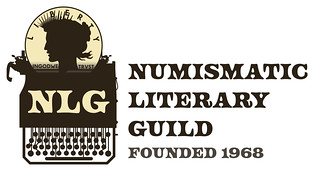 The Numismatic Literary Guild (www.NLGonline.org) has selected Charles Morgan, editor-in-chief of CoinWeek (www.CoinWeek.com), to be the organization's next Executive Director. He succeeds numismatic researcher, author, and dealer Ron Guth who served in the post for three years.
The Numismatic Literary Guild (www.NLGonline.org) has selected Charles Morgan, editor-in-chief of CoinWeek (www.CoinWeek.com), to be the organization's next Executive Director. He succeeds numismatic researcher, author, and dealer Ron Guth who served in the post for three years.
The NLG is a nonprofit organization composed of more than 200 editors, authors, writers, bloggers, and club newsletter editors as well as online content and audio and video producers. Membership is open to anyone, professional or amateur, who covers news and feature stories about all forms of money, medals, and tokens as collectibles. Membership dues are $15 a year. Information about joining is available online at www.NLGonline.org/membership.
"I take this position as NLG Executive Director with humility and gratitude. I am fortunate to be entrusted with this responsibility," said Morgan who becomes the 12th executive director of the organization founded in 1968. "The NLG serves an important purpose in the field of numismatics and is an institution near and dear to the hearts of its members. I would like to see its presence and reputation grow."
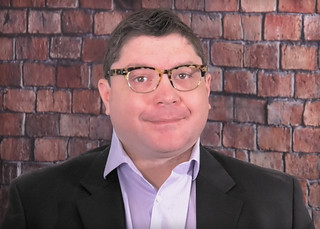 Morgan joined CoinWeek in 2013 and has helped grow the website's audience from 45,000 to 1,000,000 unique monthly visitors and guided its YouTube channel from 2,500 to 37,000 subscribers. He is co-author with Hubert Walker of the reference book, 100 Greatest Modern World Coins, and has won 18 NLG awards for his writing, podcasting and video production work.
Morgan joined CoinWeek in 2013 and has helped grow the website's audience from 45,000 to 1,000,000 unique monthly visitors and guided its YouTube channel from 2,500 to 37,000 subscribers. He is co-author with Hubert Walker of the reference book, 100 Greatest Modern World Coins, and has won 18 NLG awards for his writing, podcasting and video production work.
Guth, the outgoing NLG executive director, stated: "I can't think of anyone better than Charles Morgan to helm the Numismatic Literary Guild. As an award-winning writer, he understands the importance of having an organization that supports and celebrates the creative efforts of his fellow numismatists. He has my wholehearted support."
The NLG has begun accepting entries for its annual awards competition that is open to any paid-up NLG as of May 1, 2021. The deadline for submitting entries to Awards Coordinator David W. Lange is June 5. Awards categories and rules can be found online at www.nlgonline.org/news/2021-numismatic-literary-guild-awards-competition.
The winners are traditionally announced at an awards presentation held in conjunction with the annual American Numismatic Association World's Fair of Money summer convention.
The NLG Board of Directors members are Bob Fritsch, Donn Pearlman, Michael Shutterly, Mel Wacks, and Doug Winter. Maurice Rosen serves as Treasurer and Walter Ostromecki as Secretary. For additional information about the Numismatic Literary Guild, visit www.NLGonline.org.
THE NUMISMATIC LITERARY GUILD MISSION
The Numismatic Literary Guild (NLG) is a separate organization from the Numismatic Bibliomania Society (NBS). It's an industry group for today's numismatic authors and publishers. NBS is a collector organization for anyone with an interest in numismatic literature and research of all eras. There is a natural overlap in our membership, with many individuals card-carrying members of both organizations.
NLG publishes a monthly newsletter for its members. Issues contain guest articles from NLG members focused on writing about coins, plus reading recommendations concerning current projects published by members. You can only receive this if you are a member. Dues are only $15 annually. Executive Director Charles Morgan notes that "the NLG is focused on building a year-round community to foster better working relationships between writers in our field."
With permission, here's an excerpt from the latest issue ( Vol. 63, Issue 1, April 2021) exploring the group's history. -Editor
The Numismatic Literary Guild - Why, When, Where, What, and How?
With these words put to paper and carrying the club letterhead, NLG founder Lee Martin set in motion the creation of the coin collecting hobby's premier organization dedicated to promoting numismatic writing.
Martin's goals were ambitious and forward-thinking. He sought to enroll the top talent from the ranks of professional numismatic writers, editors, columnists, book authors, and museum curators, and cultivate a community where they could come together in the spirit of openness and camaraderie, share resources, and ultimately produce better work. It was a time of tremendous growth in the area of numismatic publishing. Magazines and newspapers were going gangbusters, numismatic research was becoming ever more sophisticated, and the enthusiasm that collectors had for joining clubs was at an all-time high. The NLG quickly found a constituency and Martin was off to the races.
Not everything the NLG's founding fathers (and mothers) set out to accomplish came to fruition. This isn't all that unusual, as these things go. The NLG never built that impressive numismatic library for the benefit of its members, and despite some early work towards the goal, I'm not sure that they ever put together a working database of coin imagery as was mentioned in the club's early newsletters.
But they did create an organization that would sustain itself for more than 50 years, and during that time they enabled many memorable moments
In the issue Executive Director Charles Morgan lays out new goals for the group's future, to include engaging with the international community and "with individuals outside of the traditional numismatic landscape to recognize content that promotes knowledge about numismatics or novel representation of numismatic objects." Lastly, he addresses the current media landscape. -Editor
The numismatic hobby is rapidly changing. Older generations are handing the baton of leadership to younger ones and with that shift, the hobby will experience a period of new sensibilities, ideas, and scholarship. It is up to us, as an organization focused on numismatic literature, to stay on top of developments in the media space. Yesterday's crude numismatic newsletter is today's Instagram account. Yesterday's house organ is today's blog section at a major company. As an organization, we must acknowledge these changes and support our members in their endeavors even if numismatic writing and content production takes forms that would have been unrecognizable years ago. Forever onward!
Good luck to NLG in the new era. We'll look forward to reporting on and participating in future developments. If you're a numismatic writer and aren't currently a member, consider joining now. -Editor
For more information, see:
https://www.nlgonline.org/
ICTA REBRANDS AS NATIONAL COIN & BULLION
Another numismatic industry group is undergoing a change - the Industry Council for Tangible Assets (ICTA) is changing its name and branding to better reflect its mission. Here's the press release. -Editor
Introducing ICTA New Brand Identity
Big news! Today, after 36 years, we are releasing a new brand identity, which includes a new name, logo, and website.
The time has come to specify the mission of the Industry Council for Tangible Assets in our branding, including our name and logo. We do not represent the broad range of collectible tangible assets that our name implies, which could include anything from antiques to postage stamps to memorabilia to fine wines, and much more.
Our association has been dedicated to the numismatic and precious-metals bullion communities for its more than 36 years of existence. During that time, we have been promoting and safeguarding the interests of our members and serving as the numismatic industry watchdog over federal and state governments in the United States to maintain a favorable legislative and regulatory climate. Over the years we have grown to better address the needs that have always been our focus:
1. Providing a medium through which our members may confer, consult, cooperate with, and educate government and other agencies to achieve solutions for problems that affect their businesses
2. Offering our members assistance and information on new and existing laws and regulations, and promoting harmony and cooperation among our members to advance the welfare of the numismatic and precious-metals bullion communities
Our brand now needs to be updated to emphasize that work. We are revamping our current branding to clarify the communities we serve—collectors of, and dealers and investors in, numismatics and precious-metals bullion. With that comes a new name, new logo, new colors, and a new look and feel. This will include our social media, email marketing, and even our website, to build a cohesive style and voice that consistently reflects our brand and our target communities. These changes will be gradual, rolling out over the next few months.
Most importantly, our core mission will remain the same. Who we are has not changed. We have been supporting our members and the community at large for well over three decades, helping to maintain a favorable legislative and regulatory environment for doing business, and we will continue to be the place with the resources and guidance collectors and dealers need to do business under the existing laws and regulations. That is still who we are and what we care about. With that, we would like to introduce you to the National Coin & Bullion Association!
 We are also proud to introduce our new logo.
We are also proud to introduce our new logo.
The logo has three components: the symbol, the logotype, and the slogan. The symbol, a Capitol dome, represents our work advocating for top priorities and fair business practices to legislators and agencies nationwide. It is surrounded by a circle of stars to imply strength and stability. The logotype, NATIONAL COIN & BULLION ASSOC, and the slogan, "TAXATION · ADVOCACY · EDUCATION," surround that and convey the three themes in our mission statement. The design is done in patriotic colors and a blue font, to indicate the scope of our activity.
In the coming months, you will see the new NCBA logo being used prominently. It will be used on our new website and it will appear on our various forms of marketing. That is right—our website got a makeover! A modern, professional look, with a responsive design that renders well on mobile devices and is easy to navigate.
With a signed logo-usage agreement, members may use a special version of this logo (to be determined) to display on their websites, advertising, business cards, and the like. Fully implementing a change like this takes time, so there may be some instances where you will see the old logo being used for a while yet.
Last, but not least, we wish to thank all the board members that submitted ideas for a new name. Director Max Spiegel's name idea was selected by the executive committee. A special thank you also to Heritage Auctions numismatic marketing manager Denice Brackemyre and senior art director Chris Britton for designing the new logo.
(We will continue to use the "Industry Council for Tangible Assets" as the registered business name; we've registered a "doing business as" (DBA) for the National Coin & Bullion Association.)
To read the complete article, see:
Introducing Our New Brand Identity
(https://www.ictaonline.org/news)
MPC FEST XXII/2021 REPORT
MPC Gram is a newsletter for collectors of Military Payment Certificates and other military numismatica. The yearly MPC fest is an annual gathering of readers organized by editor Fred Schwan and avid contributors and readers. For the second year in a row the Fest was conducted online due to the COVID-19 pandemic. Here is the post-Fest press release, compiled and submitted by Helen-Louise Boling, public information officer. -Editor
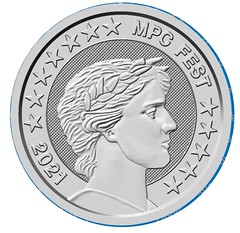 Fest XXII/2021 is now in the history books, and it is time to honor those honored for their work in this specialized field of numismatics. We are pleased to announce honorees in four categories.
Fest XXII/2021 is now in the history books, and it is time to honor those honored for their work in this specialized field of numismatics. We are pleased to announce honorees in four categories.
Many who come to Fest do so for the opportunity to share new research and findings, their own or that of others. Shepherded by the skilled hands of Ray Feller, co-training officer and co-author of Silent Witnesses with her father, Steve Feller, 19 individuals presented using the Zoom format. Each of the 19 individuals was eligible to be selected by secret ballot as winner of the Bob Olson Award, presented annually to the most outstanding presenter. The award commemorates Bob Olson, a Fester who died several years ago. Bob presented every year at Fest because of his dedication to sharing numismatic knowledge with others. His presentations were carefully crafted and he sought each year to improve his skills over the previous year. Not a "natural" presenter, as some are, he was there every year to share his work and love of the subject with the rest of us. He is sorely missed.
This year four individuals are honored. In fourth place is Jayson Salibay, MD, another first timer at Fest in a year when first timers certainly made their mark. Jayson's presentation was on Philippine emergency and guerrilla currency of World War Two. In second place are two individuals who have each won previously. Jim Downey's presentation on Sgt James Plummer, former Japanese prisoner of war, and the numismatic material he was able to bring home from the camps was complicated by uncooperative technology, but the story of the young man was well worth hearing, as verified by his peers. Tied with him is another noted presenter and former recipient of this award, Steve Feller, who presented on Siege of Mafeking notes from the Boer war, a completely new topic to many of us. And finally, this year's Bob Olson Award winner, David Frank. Dave is the author, with David Seelye, of The Complete Book of World War II USA POW & Internment Camp Chits, and a noted collector of Holocaust-related numismatica. His briefing this year gave us the story of one of his major numismatic challenges: locating a note from the Stutthof concentration camp in Poland, the smallest camp and last to be liberated. This very moving presentation, illustrated with many rare photographs and other images, gave a clear picture of life in this most dreadful of the camps, as well as of an exceedingly rare note. David Frank's dedication to Fest, sharing knowledge, and especially to the memory of the lost ones that he studies makes him a fit recipient of this award. The highest award of the military numismatics seminar is the Ray Toy medal. Ray Toy was the leader in the field of Allied and Axis military currency through the 1960s and 70s. He collected, researched, studied and wrote on the subject throughout this period. The four editions of his catalog are the basis for collectors today. By Fest tradition the previous recipient announces the award and makes the presentation as the culmination of a Fest's formal events. The 2019 recipient was Harold Kroll, one of the originators of Fest, and one of only three people to have attended all 22 Fests. (The other two were Fred Schwan and Larry Smulczenski). Because of the unique circumstances of the 2020 Fest, no Ray Toy Award was given. However, the announcement of this year's co-recipients was a definite high point. The MPC Fest XXII/zFest II 2021 recipients of the Ray Toy Award are Kathy and Dan Freeland. Service to the hobby could just as well be their middle name. They have supported and attended Fest for more than ten years, making presentations and competing in March Madness*. Both are writers, of both books and articles. Kathy is the co-author of American Red Cross in World War II Collectors' Guide, with Jim Aitken and Garry Arva. In the uniform of a Red Cross "doughnut dollie" she leads the traditional singalong at Fest. Dan is a winner of a poker bracelet. Together they have handled payments at the Fest auction and have administered the Fest Scholarship Fund for over ten years. Totally surprised by the announcement, both were clearly moved. Kathy expressed gratitude for both of them and spoke briefly about how much the Fest community has meant to them over the years. All attendees unmuted and gave a loud round of applause for the new Ray Toy winners. And that concluded the formal activity of the Fest. Hopefully we will gather together in person next year, at Camp Leo May, Port Clinton, Ohio.For more information about MPC Gram, contact Fred Schwan at fredschwan@yahoo.com
ARCHIVES INTERNATIONAL AUCTION 66
Here is the announcement for the April 23, 2021 sale by Archives International Auctions. -Editor
ARCHIVES INTERNATIONAL AUCTIONS OFFERS RARE CHINESE, AND WORLD BANKNOTES AND SCRIPOPHILY ALONG WITH HUNDREDS OF BONDS AND SHARES AT ITS APRIL 23rd, 2021 PUBLIC AUCTION IN RIVER EDGE, NEW JERSEY
The auction will be held by Archives International Auctions at their offices in River Edge, N.J.
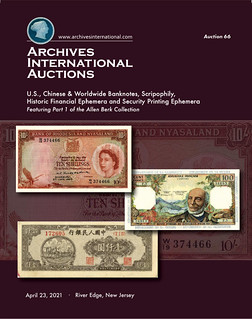 The April 23rd, 2021 auction, held in 3 sessions, by Archives International Auctions is highlighted by the Allen Berk World Banknote Collection featuring hundreds of exceptional world banknotes, many having never been offered previously at auction or having been off the collecting market for decades. Allen, as an artist as well as world traveler, had a discerning and amazing eye for beauty, condition and rarity in his collecting pursuits which is evident in the banknotes offered in this and subsequent auctions. In addition to selections from the Allen Berk Collection, there are over 200 lots of Chinese, Hong Kong and Asian banknotes in the first part of the auction. Many of the notes are in exceptional if not the highest known condition with many rarities present.
The April 23rd, 2021 auction, held in 3 sessions, by Archives International Auctions is highlighted by the Allen Berk World Banknote Collection featuring hundreds of exceptional world banknotes, many having never been offered previously at auction or having been off the collecting market for decades. Allen, as an artist as well as world traveler, had a discerning and amazing eye for beauty, condition and rarity in his collecting pursuits which is evident in the banknotes offered in this and subsequent auctions. In addition to selections from the Allen Berk Collection, there are over 200 lots of Chinese, Hong Kong and Asian banknotes in the first part of the auction. Many of the notes are in exceptional if not the highest known condition with many rarities present.
China is highlighted by a Peoples Bank of China, 1948, 1000 Yuan, P-810a banknote rarity; four different American-Oriental Bank 1922 Specimen banknotes from Fukien and Szechuen are offered; a Chinese-American Bank of Commerce, 1920 $1, Front and back proofs; a Hong Kong, 1977, $500, P-72d banknote; a Macau, Banco Nacional Ultramarino, ND (1944) 50 Avos, Highest graded note out of 57 graded as well as dozens of exceptional Chinese and Asian banknotes.
Over 450 World banknotes follow the Chinese and Asian session with numerous highlights offered. One of the many highlights in the sale is an Angola, 1970, 1000 Escudos, Serial Number 1 note; 2 modern Australia Polymer notes, a 1993, $10, P-52a, the highest graded out of 101 graded notes and a 2014, $100, P-61e, the highest graded out of 105 notes in the PMG census; a Bahamas, 1919 (ND 1935) 1 Pound, King George V issue is offered with 8 additional exceptional lots of Bahamas notes; and a Belgian Congo, Banque Central Du Congo, 1954, 100 Francs, P-25b, highest graded note in the PMG census is offered.
French Colonies, manly from the Allen Berk Collection, shine in this portion of the sale with many exceptional high grade notes offered such as Issued and Specimen examples of French Somaliland, Banque de L'Indochine, ND (1946) banknote pair; a pair of French Antilles, Institut D'Emission Des Departements d'Outre-Mer, 1964, 50 and 100 Francs Specimen notes, both the highest graded in the PMG census; Israel is represented by 12 lots highlighted by a 1960, 50 Lirot, P-33d, the highest graded and finest known out of 245 graded in the PMG census. Hundreds of additional World Banknotes are offered in this auction.
The U.S. banknote section includes Colonial, Continental, Obsolete, and Large and Small Type, National Banknotes, Depression Scrip and MPC with many desirable notes for every level of collector.
Session 3 includes over 370 lots of U.S. and World Scripophily highlighted by Railroads, World, Mining, Banking, Internet and dozens of other topics with many rare and desirable bonds and shares offered.
Previews will be limited and by appointment only and we will be observing strict safety precautions including the wearing of masks and observing social distancing to protect our team as well as our guests. We will do our best to accommodate anyone who desires additional information and photographs. For questions, please call 201-944-4800 or email info@archivesinternational.com.
The online catalog for the April 23rd, 2021 auction is on Archives International Auctions' website and can be viewed via the Archives International live bidding platform. It can also be viewed as a Sale 66 Virtual Catalog or downloadable Sale 66.pdf on our website. To pre-register for Live Internet Bidding, log on to the Archives International Auctions website, at www.ArchivesInternational.com .
Archives International is now working on their Summer and Fall 2021 auctions and are seeking quality consignments for future auctions or outright purchase including U.S. and worldwide banknotes, coins, stocks, bonds, stamps, postal history, historic ephemera, and autographs. To sell or consign one piece or an entire collection, please call AIA at (201) 944-4800; or e-mail them at info@archivesinternational.com
You may also write to Archives International Auctions, at 1060 Main Street, River Edge, NJ 07661, U.S.A. To learn more about Archives International Auctions and the auctions planned for April 23rd, 2021, log on to www.ArchivesInternational.com.
SOVEREIGN RARITIES LONDON AUCTION 3
Here's the announcement for the latest Sovereign Rarities sale. -Editor
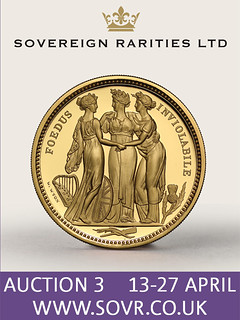 Sovereign Rarities are pleased to hold their third auction on the 27th April 2021, their first London-based sale since September 2019. The pre-bidding phase is open now at
www.sovr.co.uk until the live auction on the day, and we hope the sale contains something for everyone with coins from ancient to modern.
Sovereign Rarities are pleased to hold their third auction on the 27th April 2021, their first London-based sale since September 2019. The pre-bidding phase is open now at
www.sovr.co.uk until the live auction on the day, and we hope the sale contains something for everyone with coins from ancient to modern.
The sale begins with eight lots of ancient Greek and Roman coins, one nicely struck piece being an Augustus Denarius (lot 6, £1,500-2,000) with the standing bull on the reverse.
A short run of interesting Anglo-Gallic coins follow, with their Gothic designs including a very rare Edward the Black Prince Guyennois D'Or (lot 12, £10,000-12,000), as well as a Chaise D'Or and two Henry VI Angelots. This leads straight into the British section which forms the bulk of the sale comprising of just over 200 lots from Anglo-Saxon to modern.
Highlights of the historic British section of include a very rare Patrick of Salisbury penny struck during the Anarchy period of the 12th century (lot 22, £6,000-8,000) as well as Pevensey Mint piece of Stephen. Moving on to the hammered Tudors, an Edward VI gold Sovereign of the third period follows (lot 28, £25,000-30,000), as well as an extremely rare Dutch issue Ryal of Queen Elizabeth I NGC graded as MS61 (lot 30, £30,000-40,000). The British milled is heralded at the start with four Five Guinea pieces from Charles II to George II, with the William and Mary 1692 graded as Mint State 61+ by NGC (lot 38, £40,000-60,000), and the East India Company issue of 1729 in the reign of George II graded as Mint State 61 (lot 39, £40,000-60,000).
The auction also has a prominent modern coin component which features several of the new Three Graces series from the Royal Mint dated 2020, with the highlight being a gold One Kilo Three Graces graded by NGC as PF70 Ultra Cameo, First Day of Issue (lot 182, £90,000-100,000). Additionally, the auction includes many rare and high-grade World Coins, with highlights including a presumed unique Bermudan ‘Hogge' coin found in Kent (lot 234, £5,000-8,000), as well as twelve lots of USA coins including an MS60 graded 1811 gold five dollars (lot 290, £3,000-4,000). The auction closes with an interesting collection of siege coins from Europe and some emergency paper currency issues. The online only auction has two weeks of pre-bidding from the 13th of April and will end with the live sale at 10am GMT on the 27th April, there is no printed catalogue and enquiries are welcome to info@sovr.co.uk
NUMISMATIC NUGGETS: APRIL 18, 2021
Here's a selection of interesting or unusual items I came across in the marketplace this week. Tell us what you think of some of these. -Editor
Anonymous. Ca. 225-214/212 B.C. AR quadrigatus (24.5 mm, 6.67 g, 7 h). Rome mint. Laureate janiform head / Jupiter, holding scepter in his left hand and hurling his thunderbolt from his right, standing right in a quadriga, driven to the right by Victory who stands beside him; below, tablet inscribed with ROMA in incuse letters. Crawford 29/3; Sydenham 64A. Nice EF. Spectacular.
From Agora Auctions May 2021 sale. -Editor
To read the complete lot description, see:
Lot 144. Anonymous. Ca. 225-214/212 B.C. AR quadrigatus. Rome mint. Spectacular. From the Trausnitz Collection, ex Lanz 68, 6 June 1994, 280.
(https://agoraauctions.com/listing/viewdetail/51138)
1801 U.S. Large Cent
Countermarked "J. WORSLEY" (raised letters within an arc)
Brunk W-888.
Ex. Q. David Bowers collection.
From Bob Merchant's eBay listings. Neat curved counterstamp. -Editor
To read the complete lot description, see:
1801 U.S. Large Cent Counterstamp "J. WORSLEY" (Raised Letters within Arc)
(https://www.ebay.com/itm/1801-U-S-Large-Cent-Counterstamp-J-WORSLEY-Raised-Letters-within-Arc/133723741400)
ALGERIA: French Colony, brass brothel token (4.60g), ND, Lec-191, 29mm, facing head of cat, * AU CHAT NOIR * IMPASSE RENE CAILLE 2 ALGER // * MAISON JEANNE, 2.R. RENE-CAILLE BLIND ALLEY ALGIERS, VF-EF, R, ex Gregory J. Cole Collection. Prostitution was legal in French Algeria, but heavily regulated. An 1830 decree required sex workers to be registered with the Police Commissioner and examined twice every month, and further restricted their travel outside of the city. In 1946, the morality police recorded 46 brothels, 79 hotels, 600 furnished apartments, and a hundred clandestine houses used for prostitution in Algiers alone. Most examples of the Chat Noir tokens were issued by Maison Jouany, with Maison Jeanne being rarer.
From the upcoming Stephen Album Rare Coins Auction 40. -Editor
To read the complete lot description, see:
ALGERIA: French Colony, brass brothel token (4.60g), ND. VF-EF
(https://www.sarc.auction/ALGERIA-French-Colony-brass-brothel-token-4-60g-ND-VF-EF_i40779942)
Westminster Abbey, large gold Medal, 1965, struck in 22ct gold to mark the 900th anniversary of Westminster Abbey, facing busts of figures related to Westminster Abbey: Edward the Confessor, King Henry III, Henry Yevele (master mason), John Islip (abbot), Queen Elizabeth I, Henry Purcell (organist and composer), Dr. Richard Busby (headmaster of Westminster School), Nicholas Hawksmoor (surveyor and architect), Arthur Penrhyn Stanley (Dean), and Eric Symes Abbott (the then-Dean), rev. view of Westminster Abbey, 900 YEARS in upper left, WESTMINSTER ABBEY in exergue, edge with hallmarks, dates 1065-1965 and issue no. 706, 57mm, 125.00g (E-2107). Some minor hairline scratches, otherwise largely as struck and accompanied by original Royal Mint blue leatherette case and certificate of authenticity.
Certificate of authenticity number 706 out of 900 pieces produced.
From the upcoming Sovereign Rarities sale. -Editor
To read the complete lot description, see:
WESTMINSTER ABBEY 1965 GOLD MEDAL
THE BOOK BAZARRE
LORD ST. OSWALD 1794 HALF CENT REAPPEARS
Ron Guth published a blog article about the Lord St. Oswald 1794 Half Cent. Here's an excerpt - see the complete article online. -Editor
In 1795, an Englishman named William Strickland returned to his home following a sight-seeing trip to America that began in 1794. On his voyage home, Strickland carried with him two 1794 Half Cents, a 1793 Chain Cent, twenty-four 1794 Large Cents, three 1795 Half Dollars, two 1794 Silver Dollars, three 1795 Silver Dollars, and a mixed lot of Colonial coins. Most of the coins he acquired were in what we would call "Mint State" today and many represent the finest examples of their type known to exist. The total face value of his thirty-five coins was a mere $6.76 but, today, that small handful of coins is worth millions of dollars.
Strickland's collection wound its way through gift and inheritance to Rowland Denys Guy Winn, Major the Lord St. Oswald, M.C., whose title has stuck with the coins ever since. In 1964, the London auction house of Christie's, Manson & Woods, Ltd. sold the majority of the Lord St. Oswald Federal coins. The remaining coins, including the Colonial coins, appeared in a Christie's auction held in London in 1992.
Since 2016, none of the untraced Lord St. Oswald coins have ever appeared on the market. Thus, it was a real surprise to see this 1794 Half Cent appear as Lot 3606 in the April 23, 2021 sale of the Donald G. Partrick Collection by Heritage Auctions, where it was offered as an NGC MS64RB.
As mentioned earlier, Lord St. Oswald had TWO 1794 Half Cents, both of which happened to be of the same die variety (Cohen 9, Rarity 2). For comparison purposes, the other Lord St. Oswald 1794 Half Cent appeared as Lot 3005 in Stack's/Bowers' sale of the D. Brent Pogue Collection, where it was graded PCGS MS66RB and sold for $258,500.
The fact that Lord St. Oswald had two Mint State Red-Brown 1794 Half Cents is extraordinary considering that only ten Mint State Red-Brown Half Cents exist of all dates in the 1794-1797 Liberty Cap type.
Now that this 1794 Half Cent has been "found", there are only four "missing" Lord St. Oswald coins missing. If you run across one of them, please let me know. However, I won't be holding my breath!
To read the complete article, see:
A "Long-Lost" Lord St. Oswald 1794 Half Cent Reappears
(https://numismaticdetectives.com/blog/f/a-long-lost-lord-st-oswald-1794-half-cent-reappers)
2021 AMSA MEDAL OF THE YEAR WINNERS
Congratulations to Jeanne Stevens-Sollman for winning the 2021 American Medallic Sculptors Association Medal Of the Year award. Here's the press release. -Editor
the 2021 American Medal of the Year (AMY) Award
The American Medallic Sculptors Association (AMSA) has announced that Jeanne Stevens-Sollman has won the 2021 American Medal of the Year (AMY) award for her powerful work honoring George Floyd.
Following the tragic shootings of Anton Rose, Ahmaud Arbery, Elijah McClain, Breanna Taylor and other Blacks, when George Floyd's life was snuffed out by a white police officer in May, 2020, Jeanne Stevens-Sollman was overwhelmed, asking herself "Why? What can I do??"
Describing her inspiration, Ms. Stevens-Sollman writes: "I am an artist, working in my studio, listening to the news of these distant killings in my country that is supposed to be the land of the free. What can I do? I am a sculptor grieving for the injustice in my country. I am a pacificist trying to deal with issues that are difficult to understand. What can I do? As an artist I can try to raise awareness of the inequality of these events, to raise the level of consciousness of what people of color face on a daily basis.
As an emotional release for me, George Floyd, Black Lives Matter was created. Physically putting this story into people's hands helped me fight the anger and helplessness I was feeling at the time. Hopefully, this medal will help our citizens to be moved to find justice, to erase hate, to see more clearly that we need to live together in harmony and peace - and to achieve justice for all."
Jeanne Stevens-Sollman's American Medal of the Year features a portrait of George Floyd, along with his name, the date of his death "5•25•2020," his dying words "I CAN'T BREATHE," and "8 46," indicating the estimated time duration of 8 minutes 46 seconds that an officer had his knee on Floyd's neck. The reverse design depicts three raised fists and the inscription "NO JUSTICE NO PEACE." This slogan has been used by those protesting violence against African Americans by whites; its origin can be traced back to 1986, following the murder of Michael Griffith at the hands of a mob of white youths.
Ms. Stevens-Sollman is contributing an example of her George Floyd medal to the Smithsonian Institution's National Museum of African American History and Culture. And a limited edition of no more than 25 cast bronze examples of the large 95mm art medal can be ordered from the artist for $200 plus $12 shipping. Jeanne Stevens-Sollman will contribute all profits from the sales of this medal to Black Lives Matter. She can be contacted at j.stevenssollman@gmail.com or 814-355-3332.
Mel Wacks, Chair of the AMY Committee, revealed that "The voting was extremely close. Jeanne's outstanding medal beat out the other two finalists by only a single vote." The runner-ups both feature strong personalities - Congressman and civil rights leader John Lewis by Jim Licaretz and poet Charles Bukowski by Eugene Daub.
Jim Licaretz, formerly sculptor and engraver at the U.S. Mint, created a very high relief medal portraying Rep. John Lewis, whose quote "Never, ever be afraid to make some noise and get in good trouble, necessary trouble" and dates (1940-2020) are featured on the reverse.
When Lewis was elected to Congress in 1986, one of his first bills was the creation of a national museum to chronicle the history, culture, and successes of Black Americans. The culmination of this bill was passed in 2003 and opened in 2016 as the National Museum of African American History and Culture. And so, it is appropriate that Licaretz will contribute one of the John Lewis medals to this museum. Collectors will be able to get one of no more than 50 John Lewis 88mm. medals made from bonded bronze for $75 plus $10 shipping by contacting the sculptor at idolls@earthlink.net or 310-686-0920.
Eugene Daub, whose statue of Rosa Parks in the National Statuary Hall in the U.S. Capitol was attended by President Obama, created the other AMY runner-up medal, dedicated to poet Charles Bukowski. The reverse is an extract from Bukowski's poem How Is Your Heart:
"I always had this certain
contentment-
I wouldn't call it
happiness-
it was more of an inner
balance
that settled for
whatever was occurring …
and to walk across the floor
to an old dresser with a
cracked mirror-
see myself, ugly,
grinning at it all.
what matters most is
how well you
walk through the
fire."
All of the profits from the sale of these medals will go to the San Pedro Historical Society to help pay for a statue of long-time resident Charles Bukowski, that will also be designed by Daub. The large art medals are available for $75 plus $10 shipping (porcelain, 90mm, maximum of 150), and $195 plus $12 shipping (cast bronze, 98mm, weighing about a pound, maximum of 100). To place an order, contact Eugene Daub at eugenedaub@cox.net or 310-872-9854.
All 38 AMY entries will be pictured in the next full color issue of AMSA's Members Exchange. Art medal collectors and designers are invited to join the American Medallic Sculpture Association at www.amsamedals.org.
2020 IBNS BANK NOTE OF YEAR AWARD
Kavan Ratnatungas passed along the press release for the IBNS Bank Note of Year Award. Thanks! -Editor
The International Bank Note Society (IBNS) announces that its voting membership has selected the Banco de Mexico to receive its annual prestigious "Bank Note of the Year Award" for 2020. With well over 100 new banknotes released worldwide during 2020, only 24 were deemed of sufficiently new design to be member nominated. Almost from the start, Mexico's new 100 Peso polymer bill widely led the voting followed by Scotland's Bank of Scotland 20 Pound entry (Kate Cranston tea room/squirrels). There was a virtual tie for third place between Northern Ireland's Ulster Bank (20 Pound flora/street musicians), the Bahamas (5 Dollar statesman/junkanoo dancer) and Fiji (50 Dollar 50th Anniversary of Independence). Rounding out the top seven vote getters were the Bank of England (20 Pound Queen/J.M.W. Turner with painting) and Scotland's Clydesdale Bank (20 Pound Robert the Bruce/St. Kilda).
Now in its 60th year, the IBNS has approximately 2000 members worldwide. As a nonprofit educational organization its objectives are to promote, stimulate and advance the study, collection and dissemination of information related to paper money. From all significant newly designed and widely circulated banknotes released in 2020, the IBNS membership nominated notes from 22 different countries to place on the ballot. Nominees represented 5 continents (Africa, Asia, Australia, Europe, and South America), Central America, 3 island nations, 2 of which are in the Caribbean, and the Middle East. Past "Bank Note of the Year" winners include Aruba (2019), Canada (2018), Switzerland (2017 & 2016), New Zealand (2015), Trinidad & Tobago (2014), Kazakhstan (2013, 2012, 2011), Uganda (2010), Bermuda (2009), Samoa (2008), Bank of Scotland (2007), Comoros (2006), Faeroe Islands (2005) and Canada (2004).
Front: Mexican heroine, poet and writer
Sor Juana Indes de la Cruz
Back: The Monarch Butterfly Biosphere Reserve
temperate forest ecosystem
The Banco de Mexico was both the printer and issuer of this award-winning design banknote, which is part of the bank's current G Series introduced in 2018. The vertical format note is printed on polymer and features one of Mexico's national heroines and poet/writer Sor Juana Indes de la Cruz. The reverse "piece de resistance" image features a temperate forest ecosystem which is known worldwide as the Monarch Butterfly Biosphere Reserve. The design continues to highlight Mexican cultural and historic characteristics with new graphic motifs. Produced by the Banco de Mexico's new printing complex located in Jalisco, which began operation just before the coronavirus pandemic, the banknote has significantly improved security features which coordinate the transition to a polymer substrate. Polymer banknotes continue to be popular IBNS favorites.
As a first-time winner of the IBNS Bank Note of the Year competition, Mexico's award-winning entry may provide a template as other countries reconsider how they design and promote new banknotes. The Mexico successful design in eye-pleasing red combines Hispanic architecture, a famous female Hispanic literary figure and a tribute to the world's fragile ecosystem. The 100 Peso note is slightly narrower than a 20 Euro note and slightly shorter than U.S. greenbacks. The current exchange value of 100 pesos is USD $4.92 or 4.18 Euros as of the date of this announcement.
To read the complete article, see:
Mexico Triumphs with 2020 IBNS Bank Note of Year Award
(https://www.theibns.org/joomla/index.php?option=com_content&view=article&id=808&catid=13&Itemid=51%20index.php)
MAGNET FISHERS FIND SAFE WITH STOLEN COINS
Roger Siboni and Leon Saryan passed along this Newsweek article about a submerged safe filled with stolen coins. Thanks. I'd never heard of "magnet fishing", but I guess it can be fun. -Editor
Aself-proclaimed treasure hunter struck gold when he found a submerged safe filled with stolen coins.
Leigh Webber, who goes by Bondi Treasure Hunter online, shared a video to TikTok recounting a memorable find in an Amsterdam canal.
Leigh, originally from Australia, was magnet fishing when he and some friends came across a stretch of water with more than 46 safes buried in the riverbed.
The viral video, which has been watched more than seven million times, explains: "We went magnet fishing and found a giant safe in the river. The safe was so big we had to hire a crane to pull it out. Because this safe was so big, we thought it might have something inside it. So we decided to break it open.
"Eventually after a lot of effort we got inside and to our surprise it was filled with coins. As you can see from the protective cases these are valuable collector's coins so we reported the treasure to the police. It turns out it was stolen over 20 years ago."
The cache of coins say "Hortus Bonaticus 1682—1982 Amsterdam", and Leigh set about doing some research into their history—and value.
They're worth about £30 each. Also they were made in 1982 there was only 500 made and they're a commemorative coin made for the botanical gardens here, which is called Hortus Botanicus, for their 300 year anniversary."
To read the complete article, see:
Treasure Hunters Find Huge Safe Filled With Stolen Coins While Magnet Fishing
(https://www.newsweek.com/treasure-hunters-huge-safe-stolen-coins-magnet-fishing-1582837)
OLD BUILDING YIELDS GOLD HOARD
Leon Saryan and Arthur Shippee passed along this article about a fortunate find in a house in France. -Editor
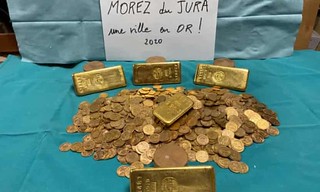 The surprise discovery of three jam jars filled with gold bars and hundreds of gold coins in an old building marked for renovation has left a mountain community in eastern France perplexed and celebrating.
The surprise discovery of three jam jars filled with gold bars and hundreds of gold coins in an old building marked for renovation has left a mountain community in eastern France perplexed and celebrating.
The mayor of Morez, a small industrial town in a picturesque valley in the Jura, said the value of the find was more than €600,000 (£520,000). Town hall staff first found three jam jars of gold bars and coins worth €500,000 at the back of a dusty shelf, then opened a safe hidden behind boxes in a wardrobe to find up to €150,000 in gold coins.
"The house was packed with objects and furniture," Petit said. "There had been several generations who didn't throw anything away, kept everything and lived really frugally. I agreed we'd buy the property as it was and we'd gradually empty its contents ourselves."
Senior staff, including the mayor, the head of services and the local museum head went in themselves. They followed social distancing rules, taking one floor each, and carefully sorted through boxes and cupboards.
"Three jars full of gold bars were sitting behind lots of other objects on a shelf," the mayor said. "There was surprise and stupefaction. None of us had ever held a piece of gold. I'd only ever seen gold bars in photos, and thought they must be huge. But these were small, weighing 1kg and the size of a cigarette packet."
The five gold bars and more than 1,000 gold coins were estimated to be worth €500,000.
The second find, which Petit announced to a surprised municipal council meeting this week, came recently when a safe found at the back of a cupboard behind cardboard boxes was broken open to find hundreds more gold coins worth up to €150,000. He said it was impossible to know who exactly in the family – involved in Morez's clock and glasses industry – had first come into the fortune.
To read the complete article, see:
French officials perplexed by gold bars and coins found stashed in old house
(https://www.theguardian.com/world/2021/apr/16/french-officials-perplexed-gold-bars-and-coins-found-stashed-old-house?CMP=oth_b-aplnews_d-1)
LOOSE CHANGE: APRIL 18, 2021
Here are some additional items in the media this week that may be of interest. -Editor
Michael Shutterly published a nice CoinWeek article on building an ancient coin exhibit. -Editor
I put on my first numismatic exhibit at the ANA World's Fair of Money in Chicago in 2015. I was pleased with the results; Sacred Images won the awards for "Best Exhibit by a First Time Exhibitor" and "First Place – Coins Before 1500."
At the ANA Awards Banquet, I found myself seated next to Larry Sekulich, who told me that he did not think that I had put on a good exhibit – he said that I had put on at least three good exhibits. My exhibit included 61 different coins covering a wide array of sub-topics, and Larry suggested that I should consider bringing more focus to my presentations.
I figured that Larry probably knew what he was talking about. Not only had he won that year's "Howland Wood Memorial Award for Best-of-Show Exhibit" (his third win of that award), but he is also the instructor for the ANA's Summer Seminar class "Creating a Winning Numismatic Exhibit".
To read the complete article, see:
The One That Got Away: The Trials and Tribulations of Building an Ancient Coin Exhibit
(https://coinweek.com/ancient-coins/the-one-that-got-away-the-trials-and-tribulations-of-building-an-ancient-coin-exhibit/)
Here's a YouTube video about how tally sticks were used in medieval England to keep accounts of debts and trades. -Editor
To watch the video, see:
Why were notched sticks so important in medieval times?
(https://www.youtube.com/watch?v=2DkyahZplFo)
Bibliophiles and researchers should hold a moment of silence for Presidential Medal of Freedom recipient Vartan Gregorian, who brought the grand New York Public Library back to glory. -Editor
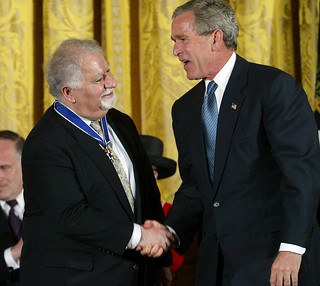 Vartan Gregorian, the ebullient Armenian immigrant who climbed to pinnacles of academic and philanthropic achievement but took a detour in the 1980s to restore a fading New York Public Library to its place at the heart of American intellectual life, died on Thursday in Manhattan. He was 87.
Vartan Gregorian, the ebullient Armenian immigrant who climbed to pinnacles of academic and philanthropic achievement but took a detour in the 1980s to restore a fading New York Public Library to its place at the heart of American intellectual life, died on Thursday in Manhattan. He was 87.
Dr. Gregorian was a fighter: proud, shrewd, charming, a brilliant historian and educator who rose from humble origins to speak seven languages, win sheaves of honors and be offered the presidencies of Columbia University and the Universities of Michigan and Miami. He accepted the presidency of Brown University (1989-1997), transforming it into one of the Ivy League's hottest schools, and since then had been president of the Carnegie Corporation of New York, a major benefactor of education.
But he was best known for resurrecting the New York Public Library from a fiscal and morale crisis. It was a radical, midcareer change from the pastoral academic realm, and a risky plunge into the high-profile social and political wars of New York City, where the budget-cutting knives were out after decades of profligacy, neglect and a brush with municipal bankruptcy in the 1970s.
To read the complete article, see:
Vartan Gregorian, Savior of the New York Public Library, Dies at 87
(https://www.nytimes.com/2021/04/16/nyregion/vartan-gregorian-dead.html)
Have too much silver bullion laying around the house? Ship it to Singapore for secure storage! -Editor
Inside a six-story high warehouse near Singapore's Changi airport, a vast hangar-like space is waiting to be filled with a precious metal that usually plays second fiddle to its more lustrous sibling.
The vault that's being built by Silver Bullion Pte Ltd. will — when completed in the first half of next year — be able to store 15,000 tons of silver. It's only holding around 400 tons of the metal at the moment, but the vacant space is an indication that silver appears to be on the cusp of a promising few years.
Demand for coins and bars is booming, fueled in part by a Reddit-induced buying frenzy in February that drove prices to an eight-year high. While the fervor has abated, retail interest is still elevated, valuations are relatively cheap and measures are being taken to meet the surge in demand. The amount of silver stored in vaults in London rose 11% in March to a record, according to the London Bullion Market Association.
To read the complete article, see:
Singapore Dealer Prepares Vault for 15,000 Tons of Silver
(https://finance.yahoo.com/news/singapore-dealer-prepares-vault-15-022209368.html)

